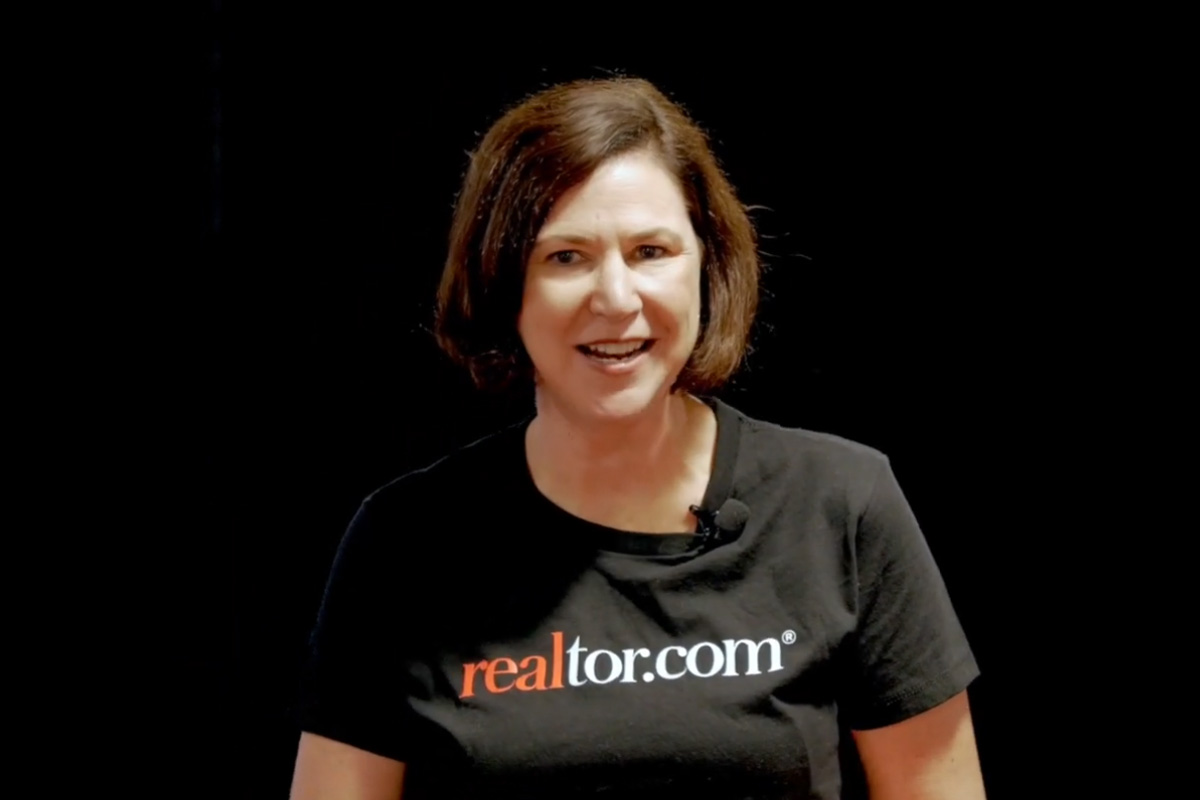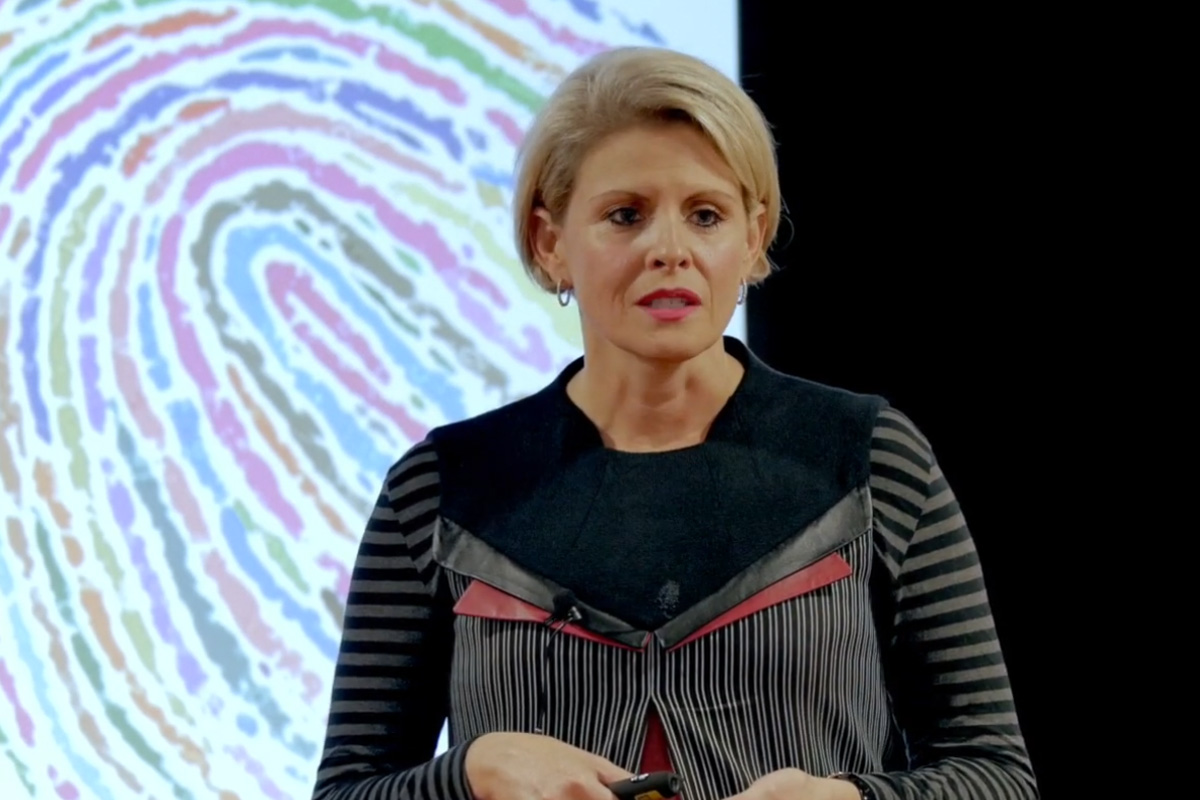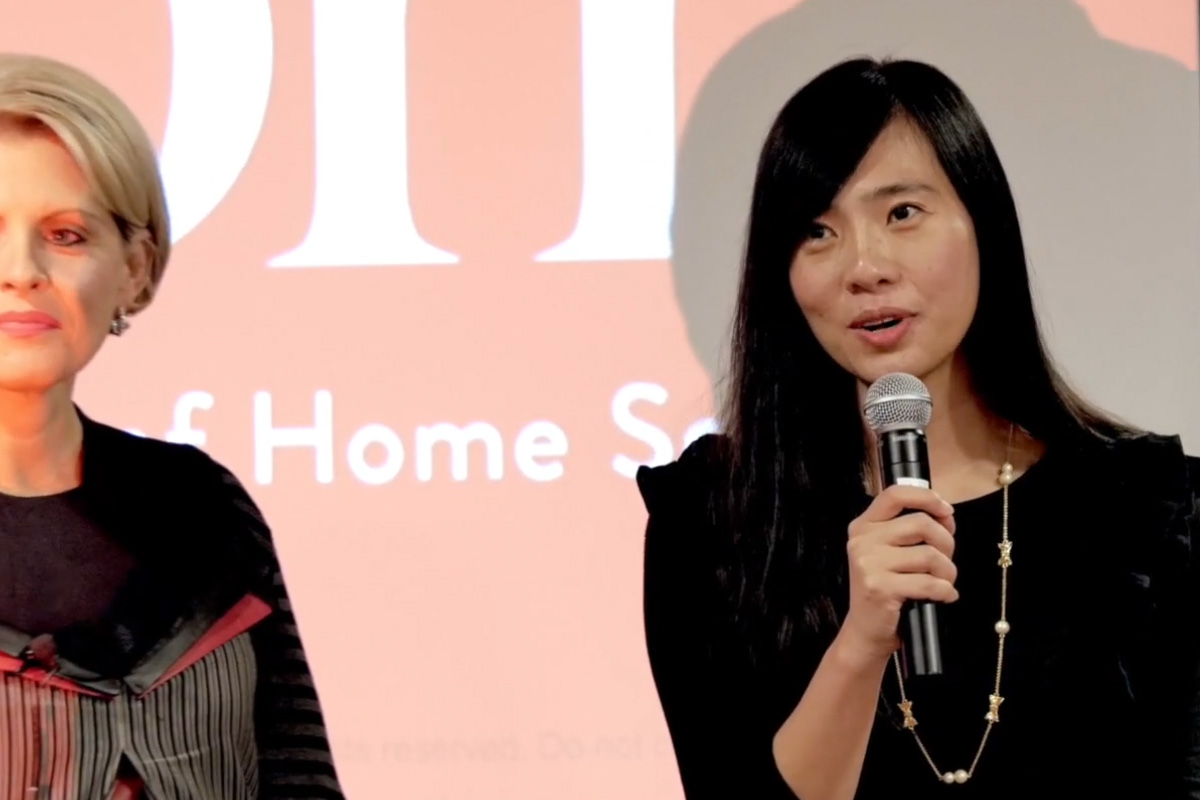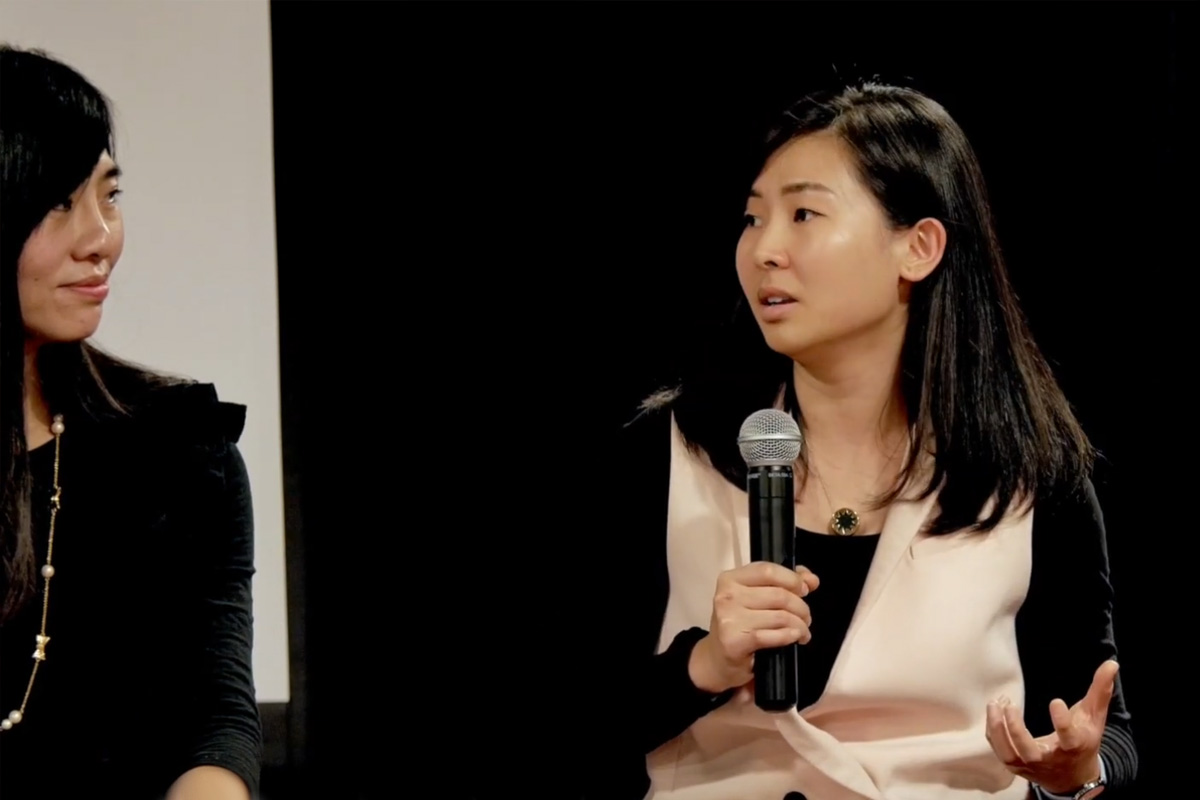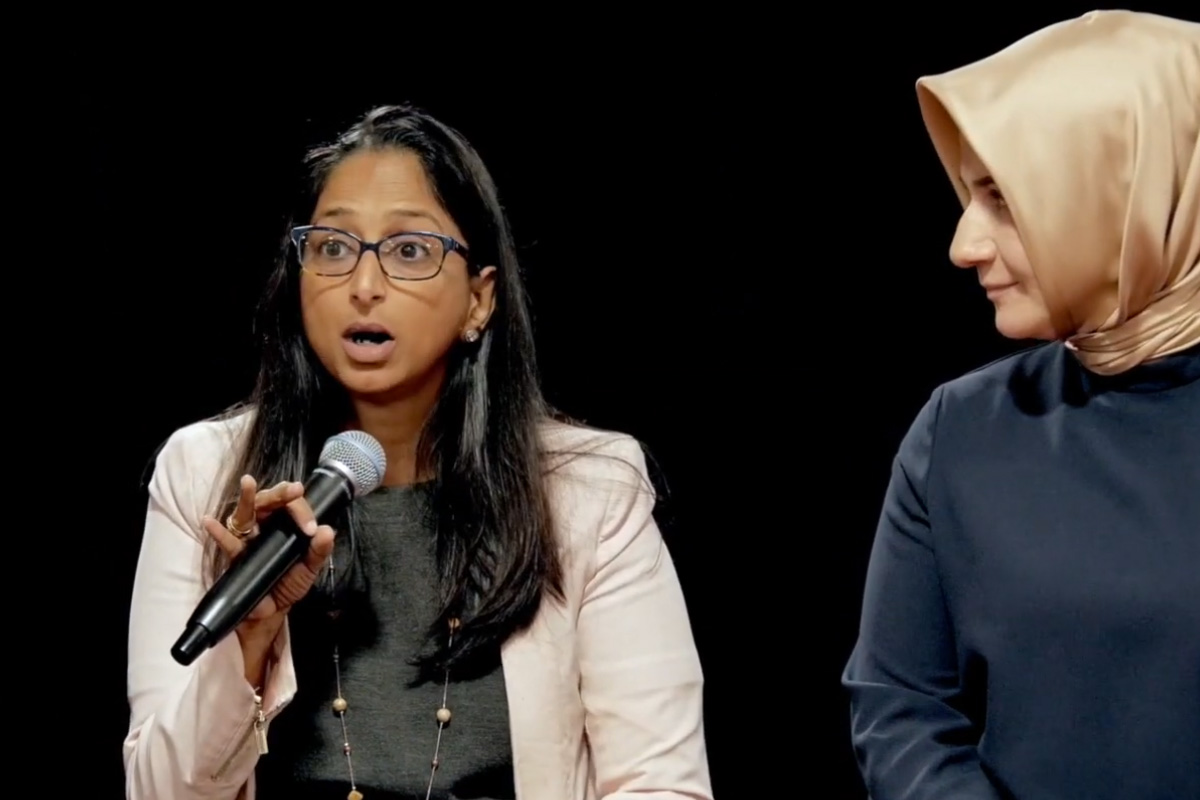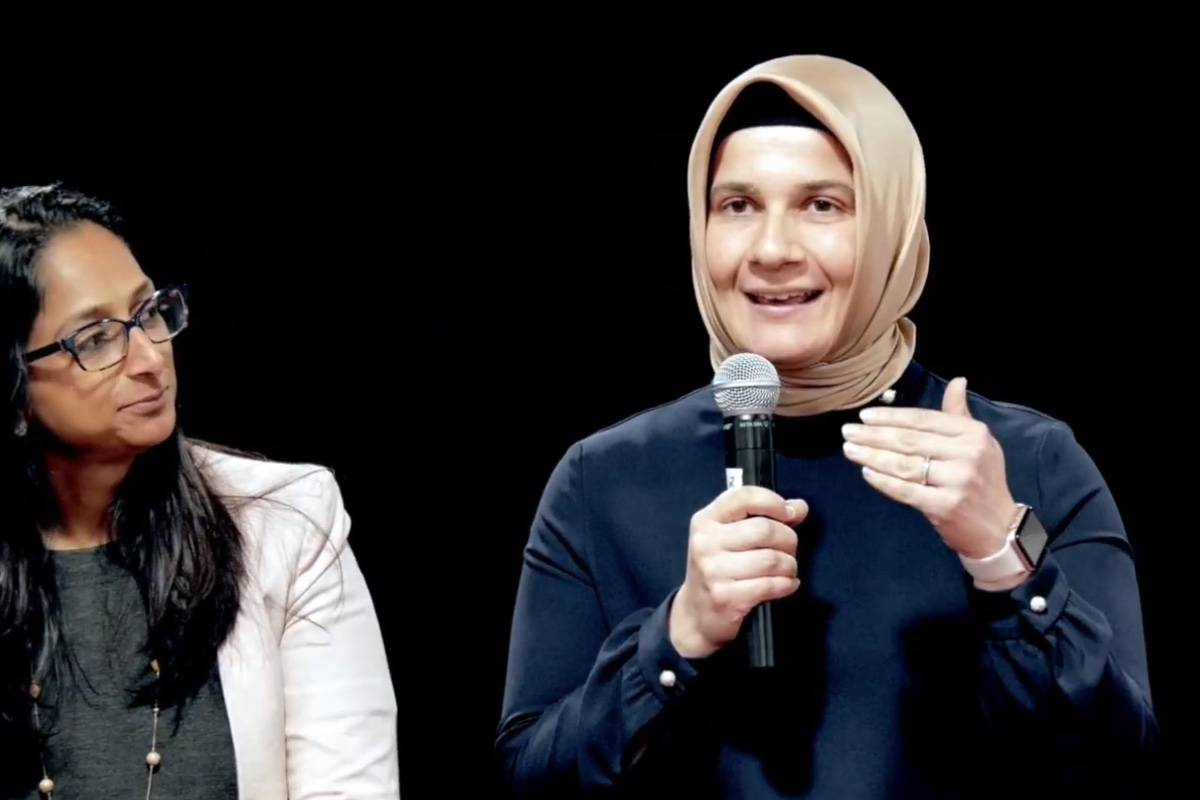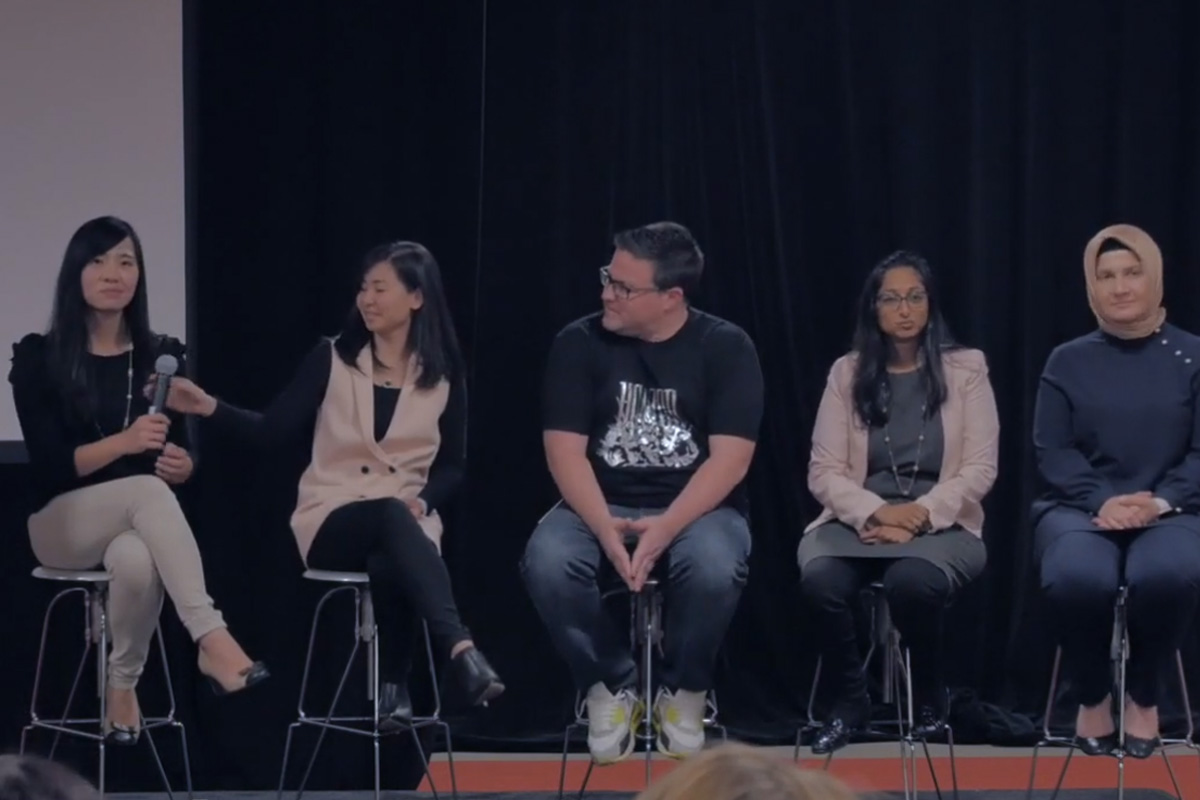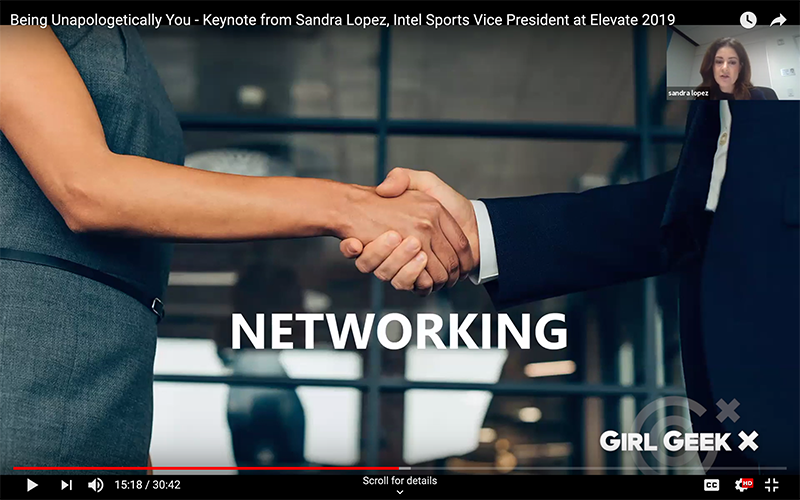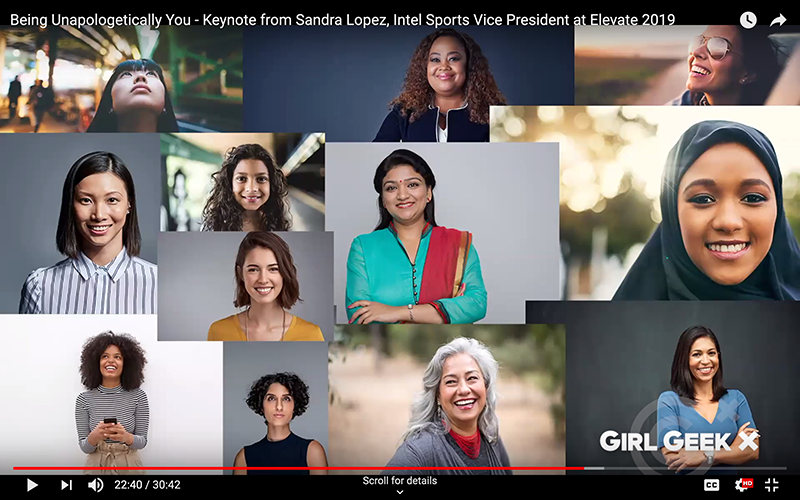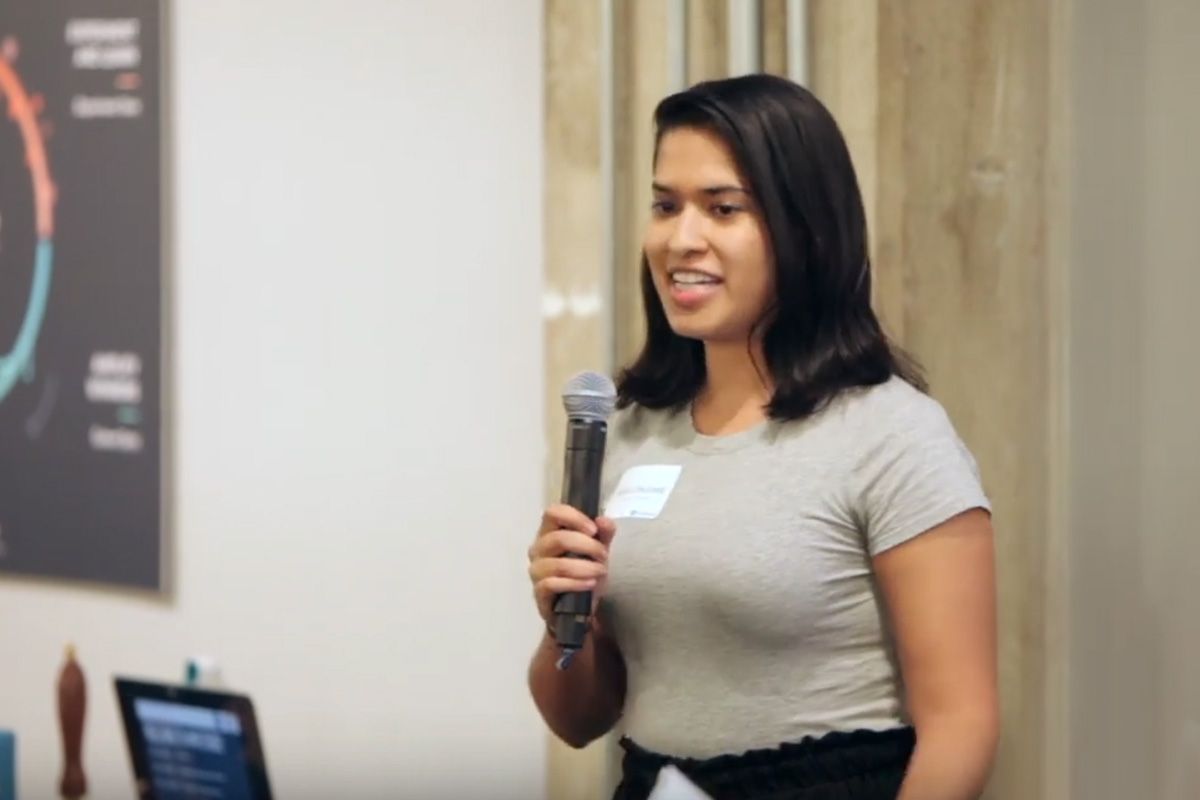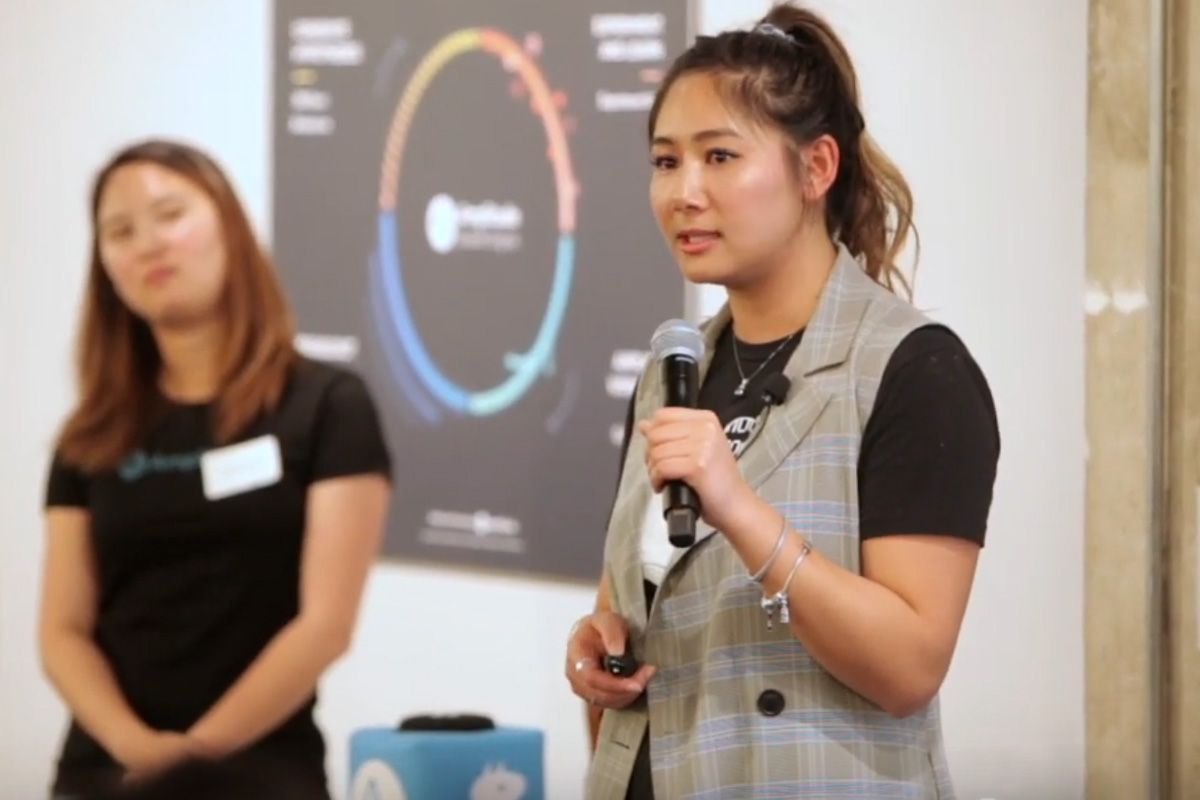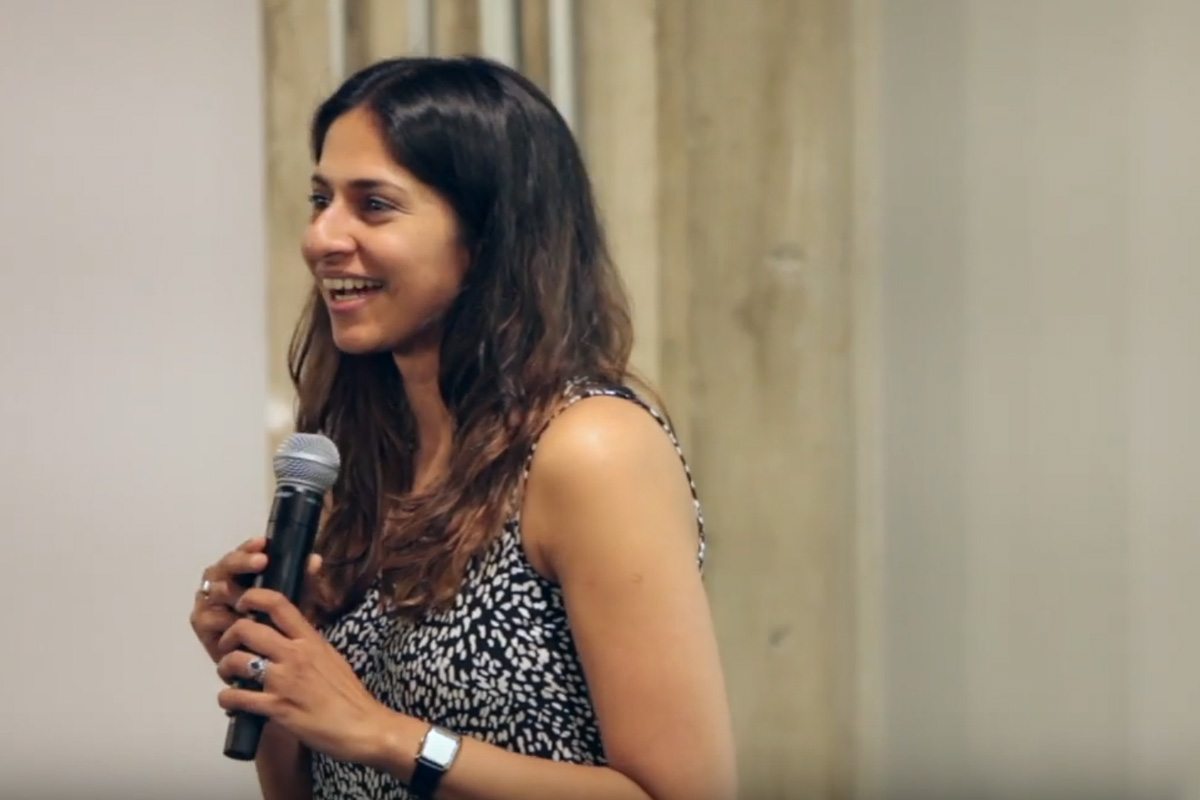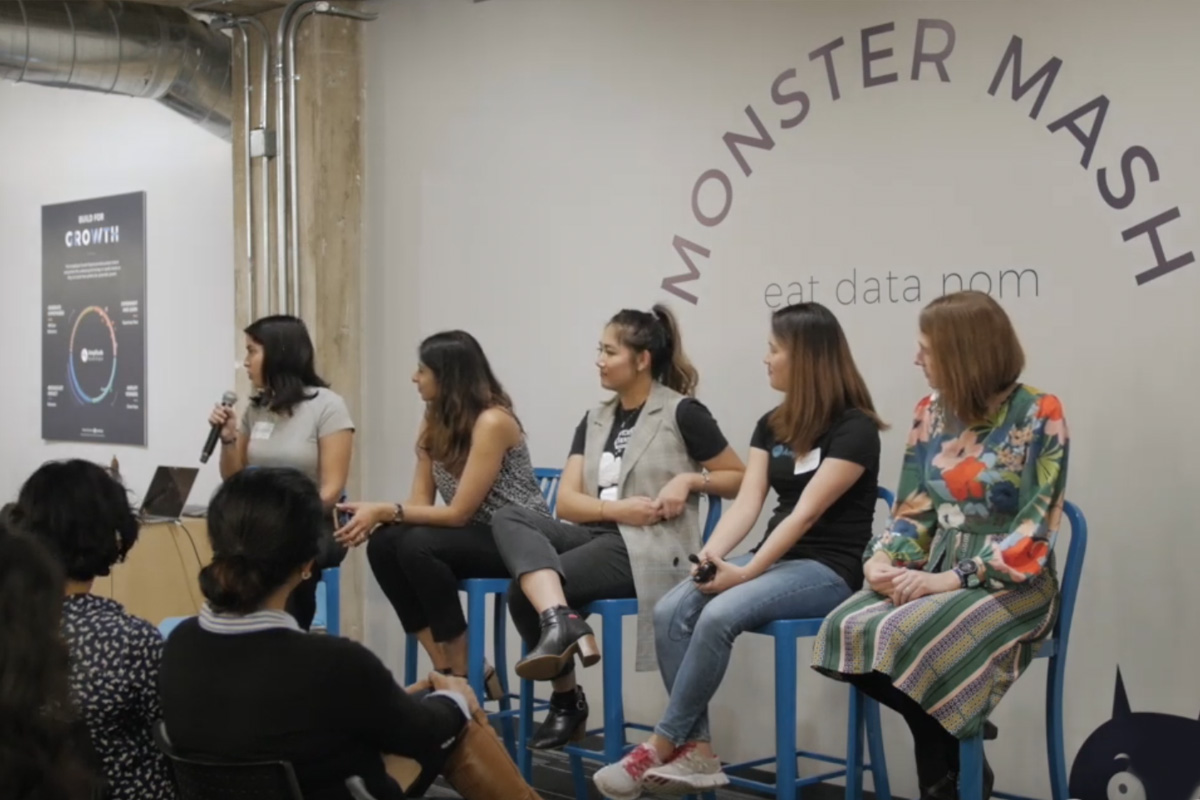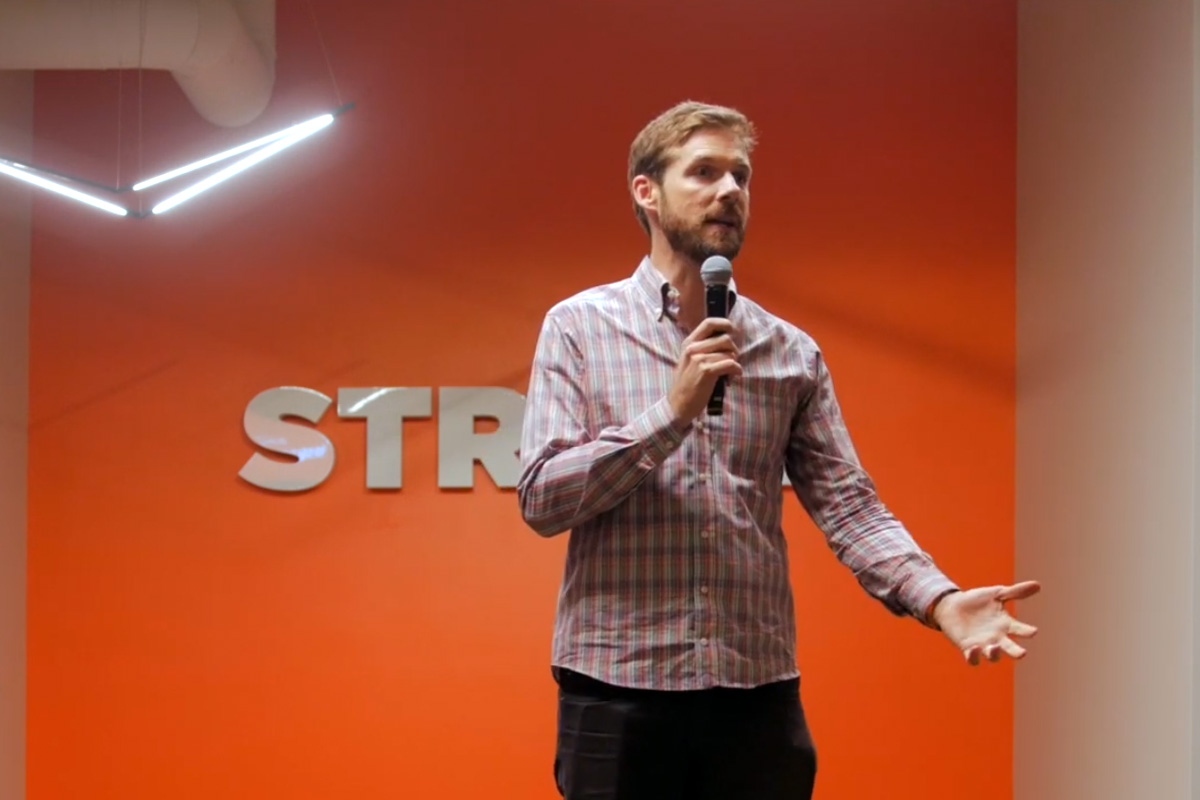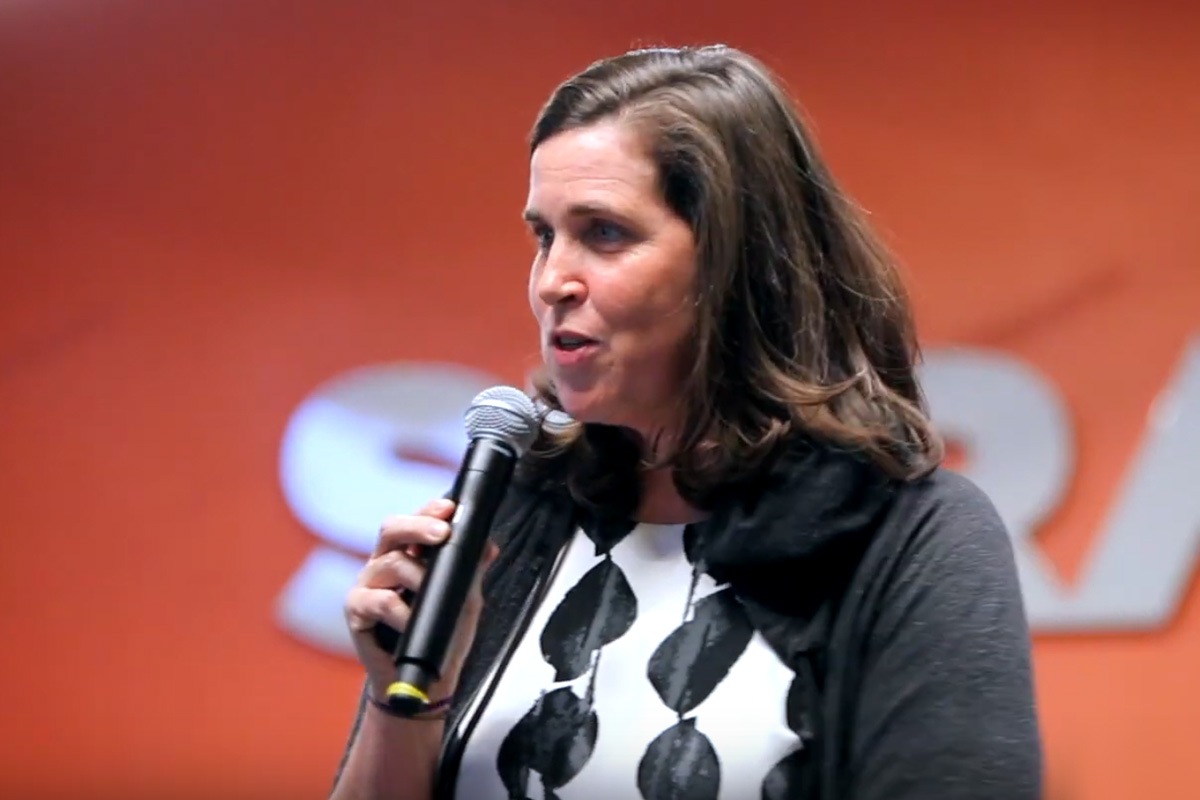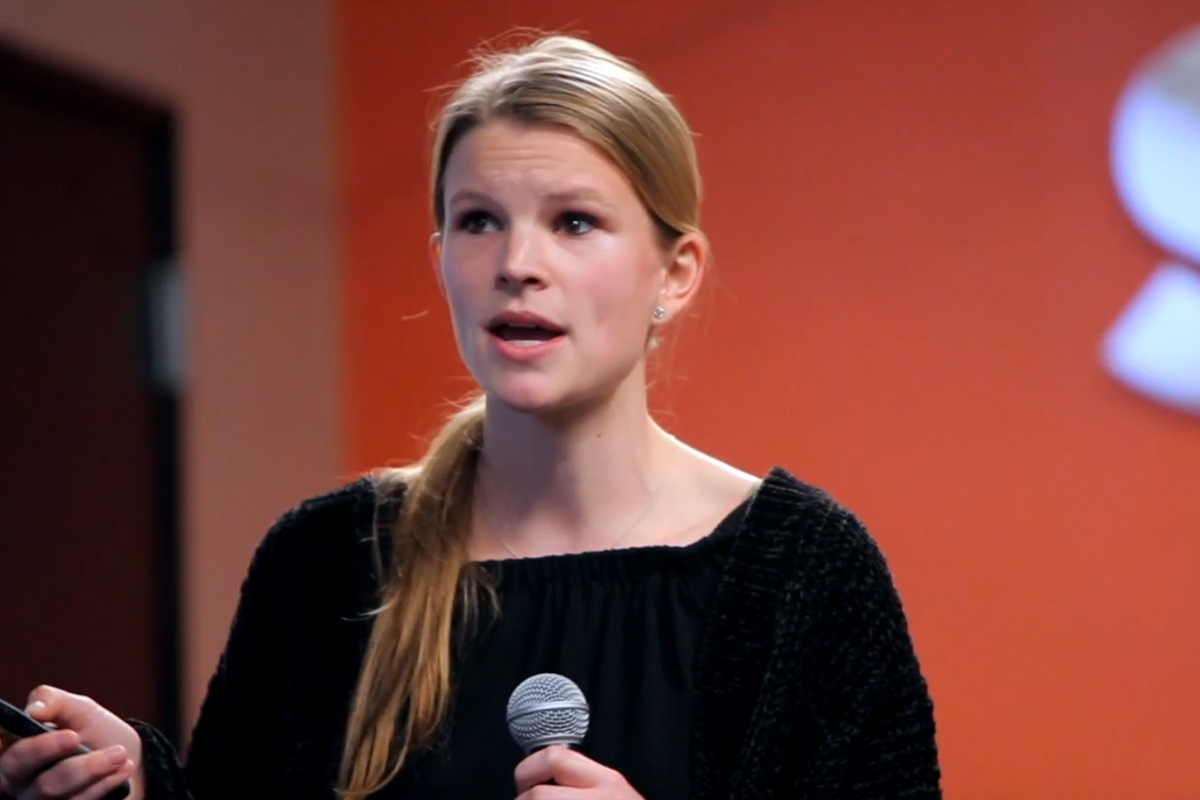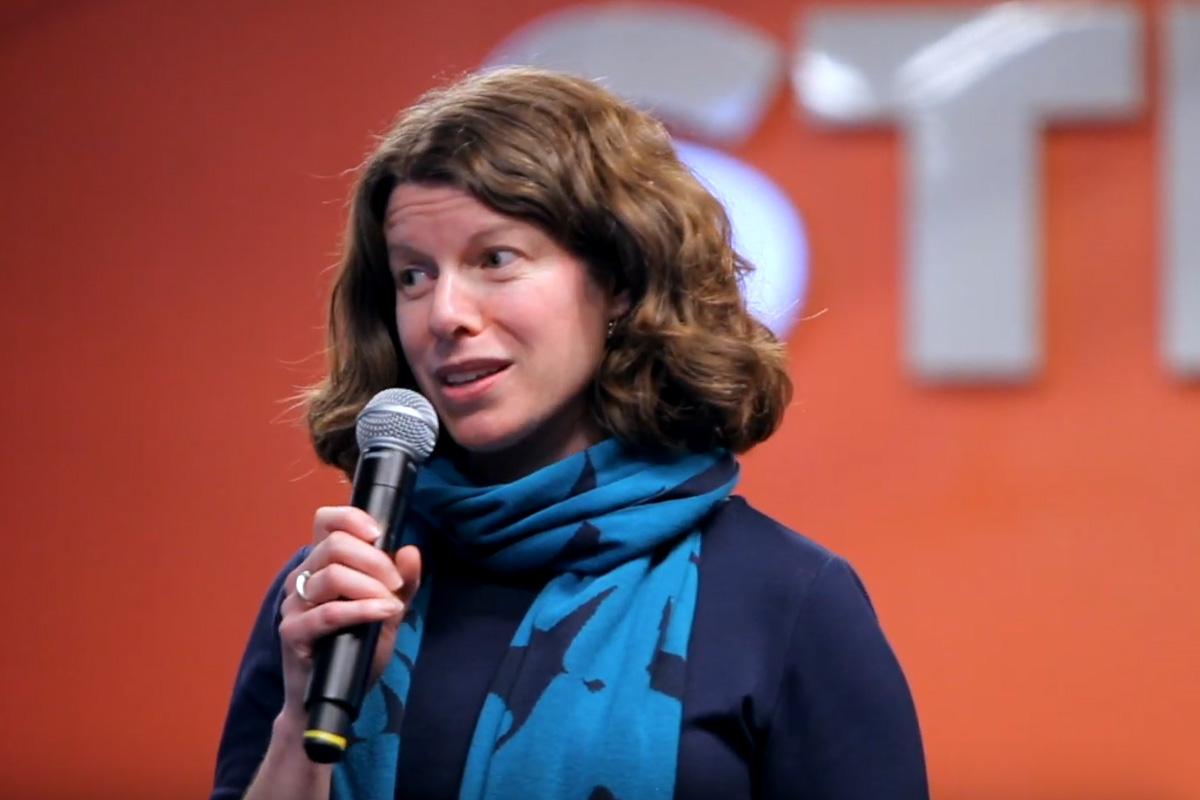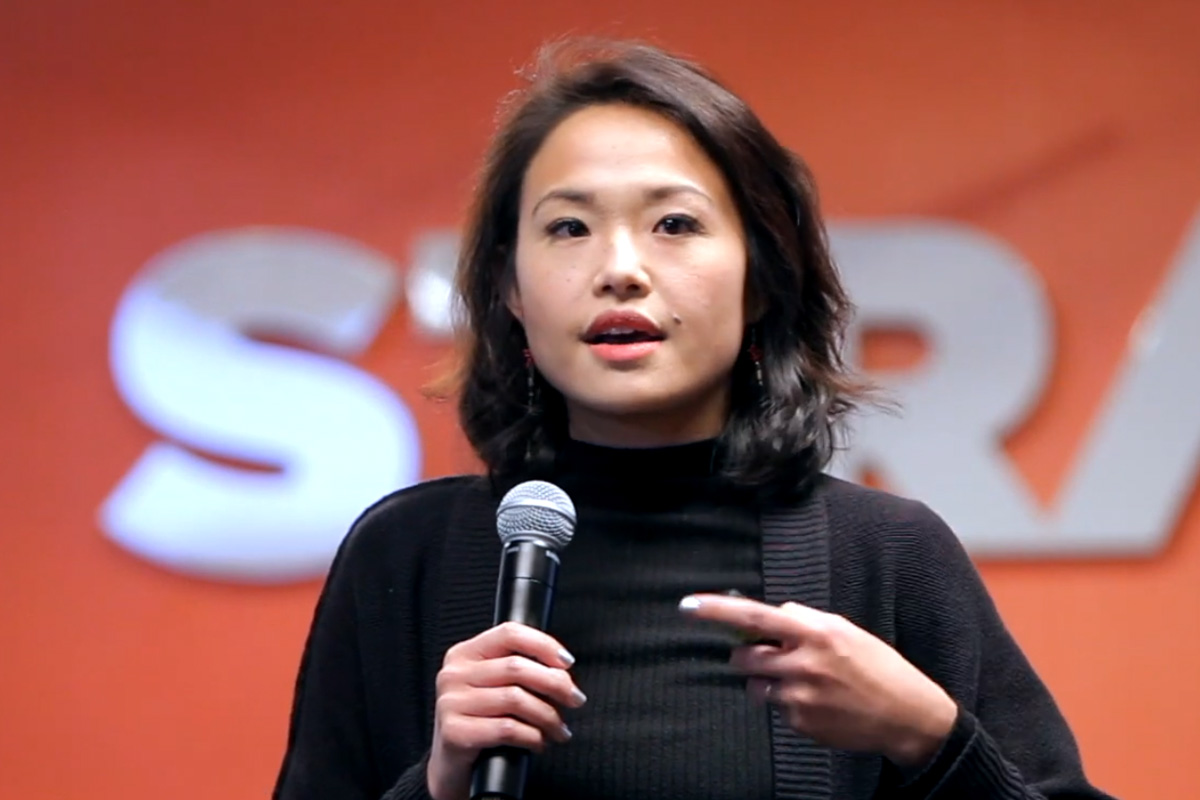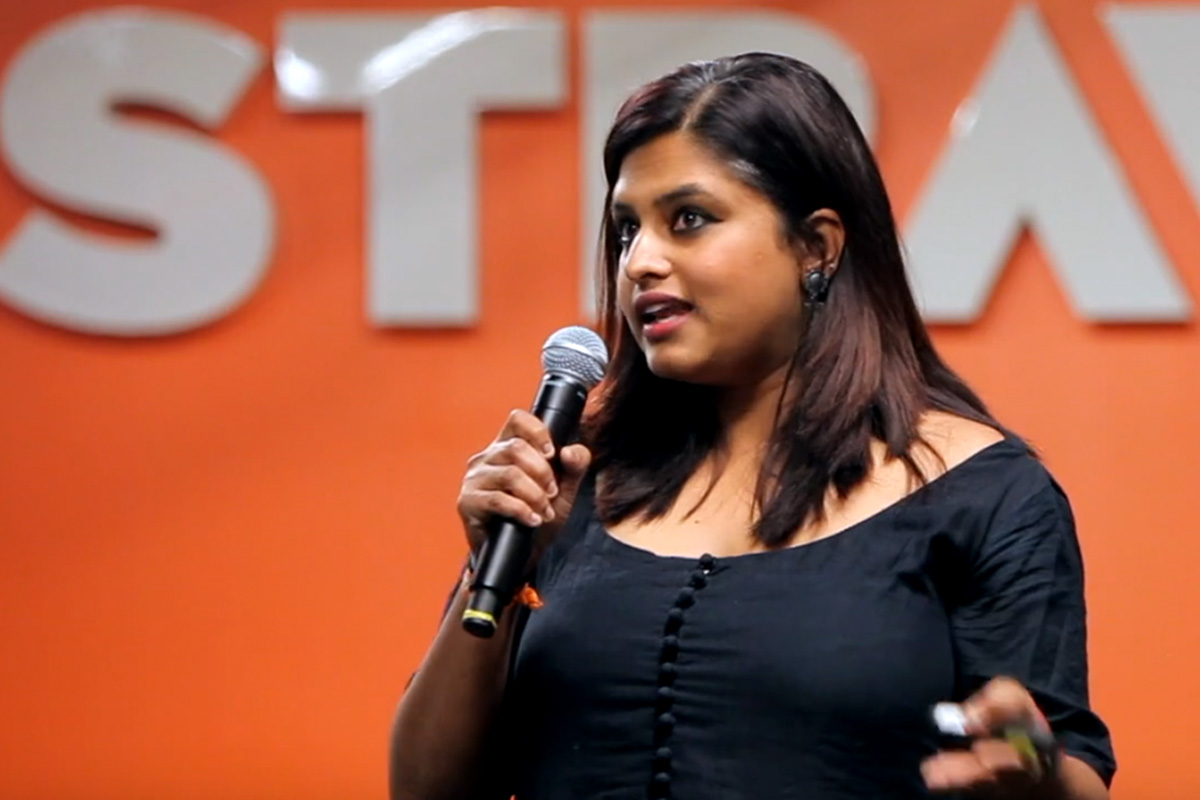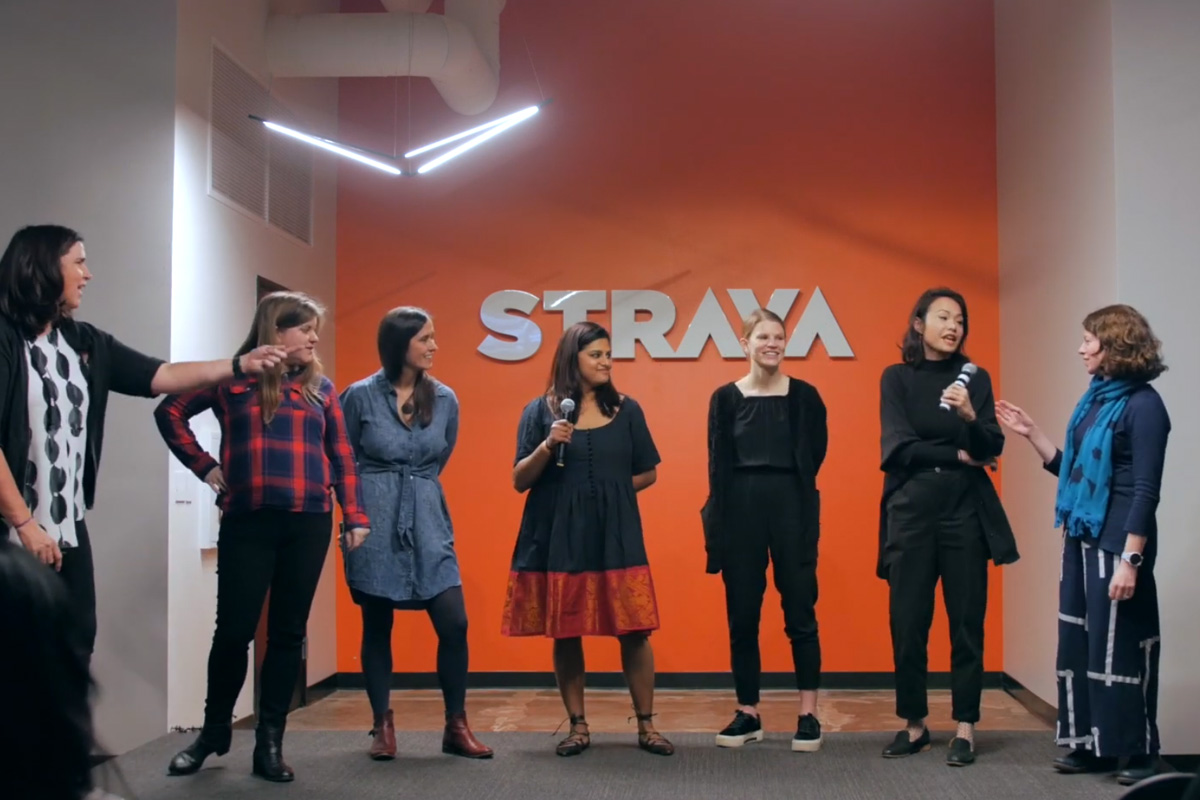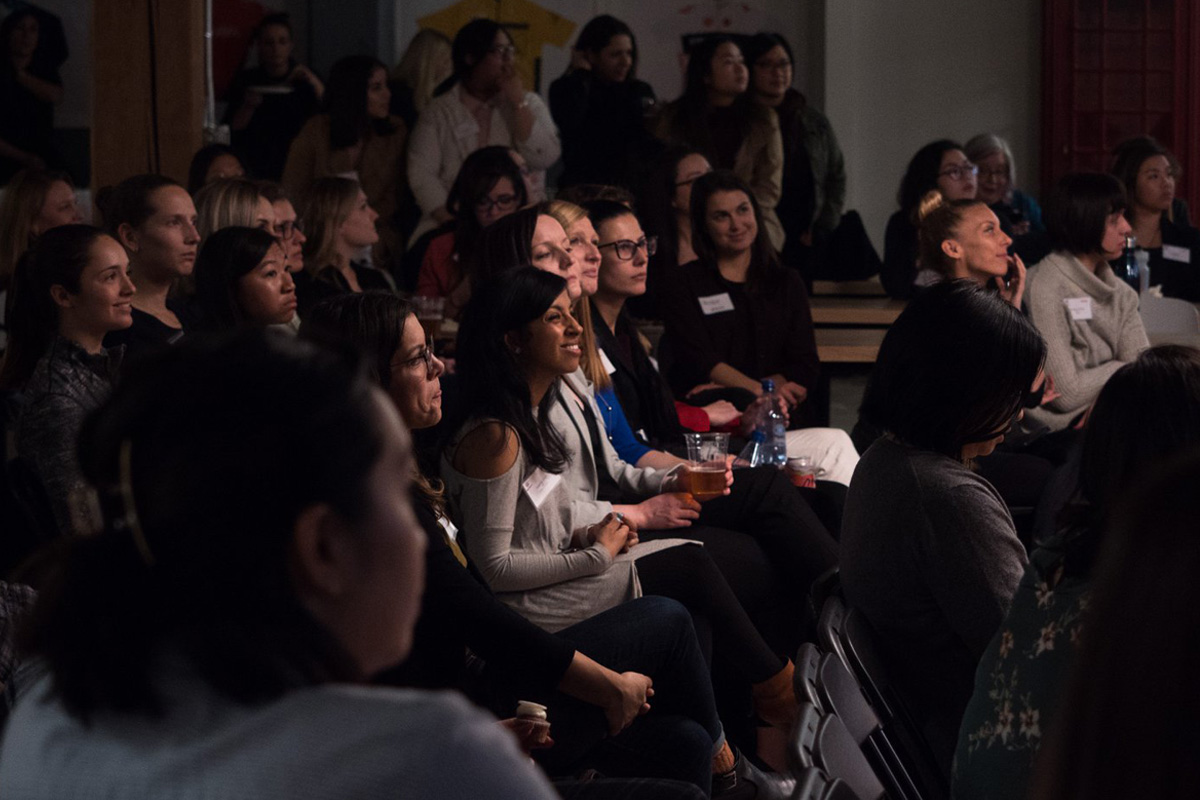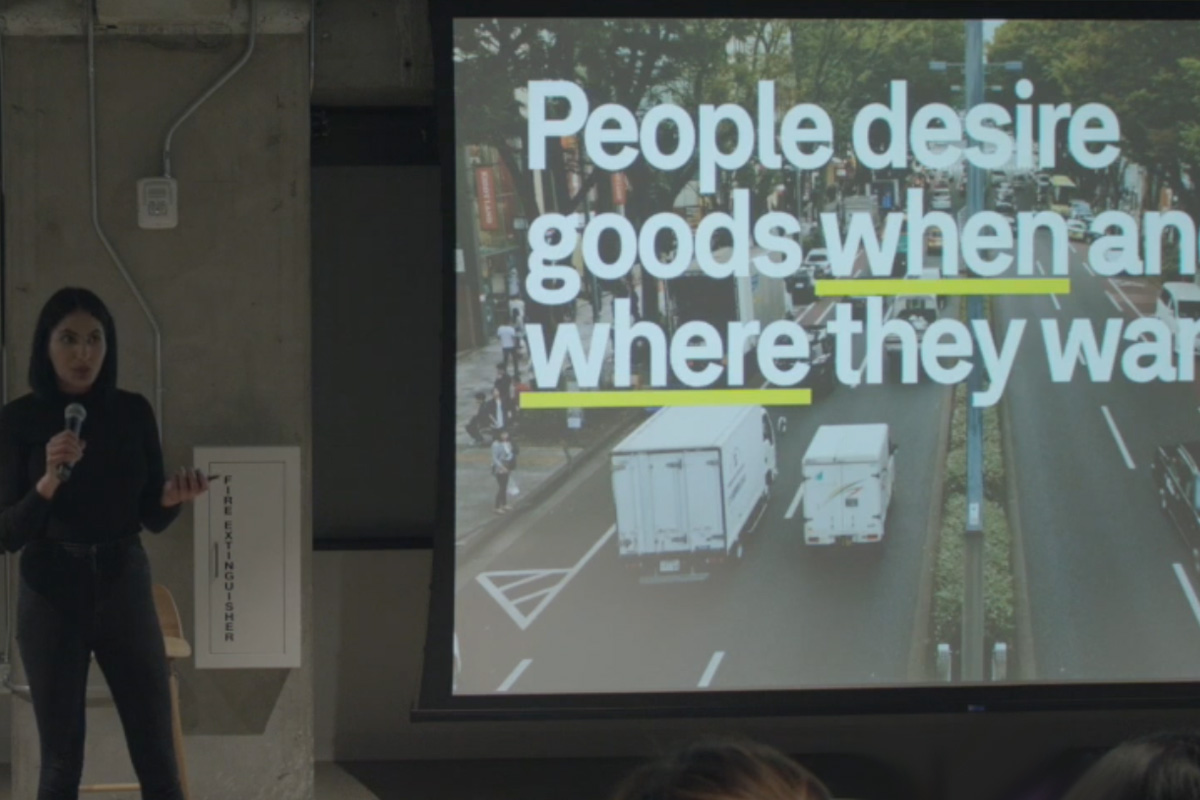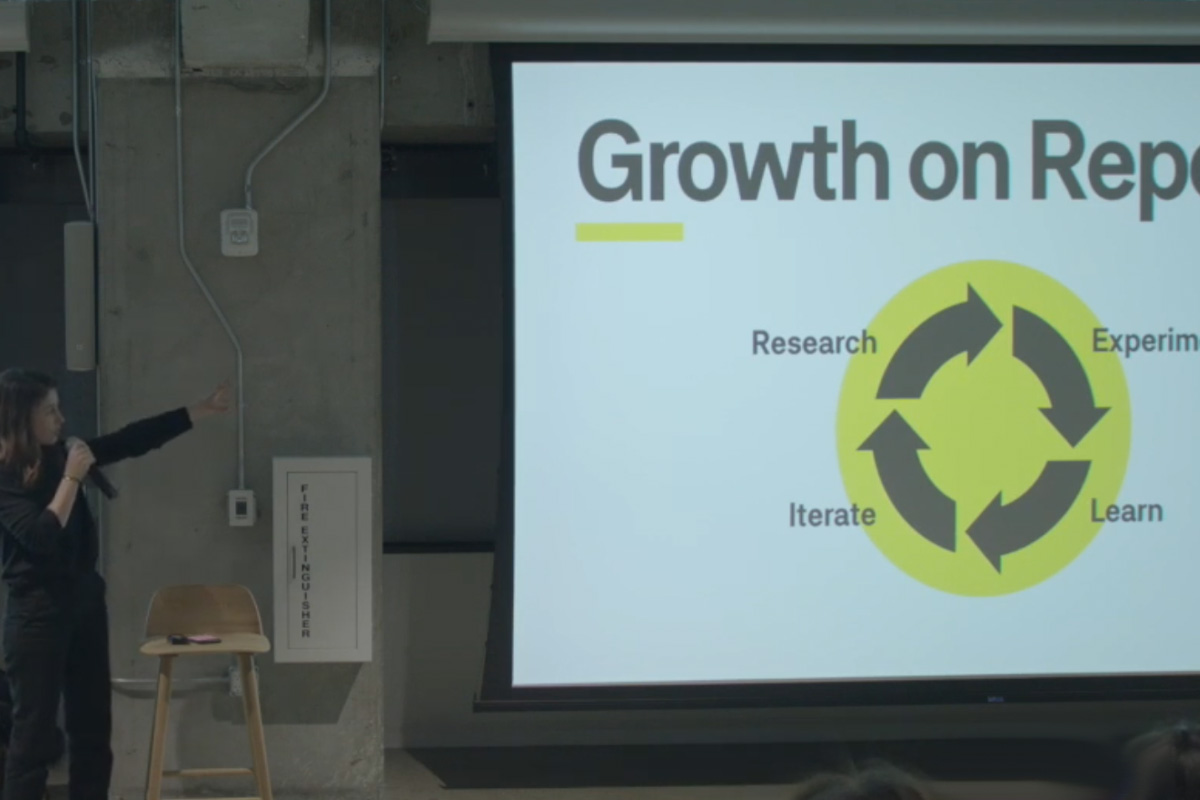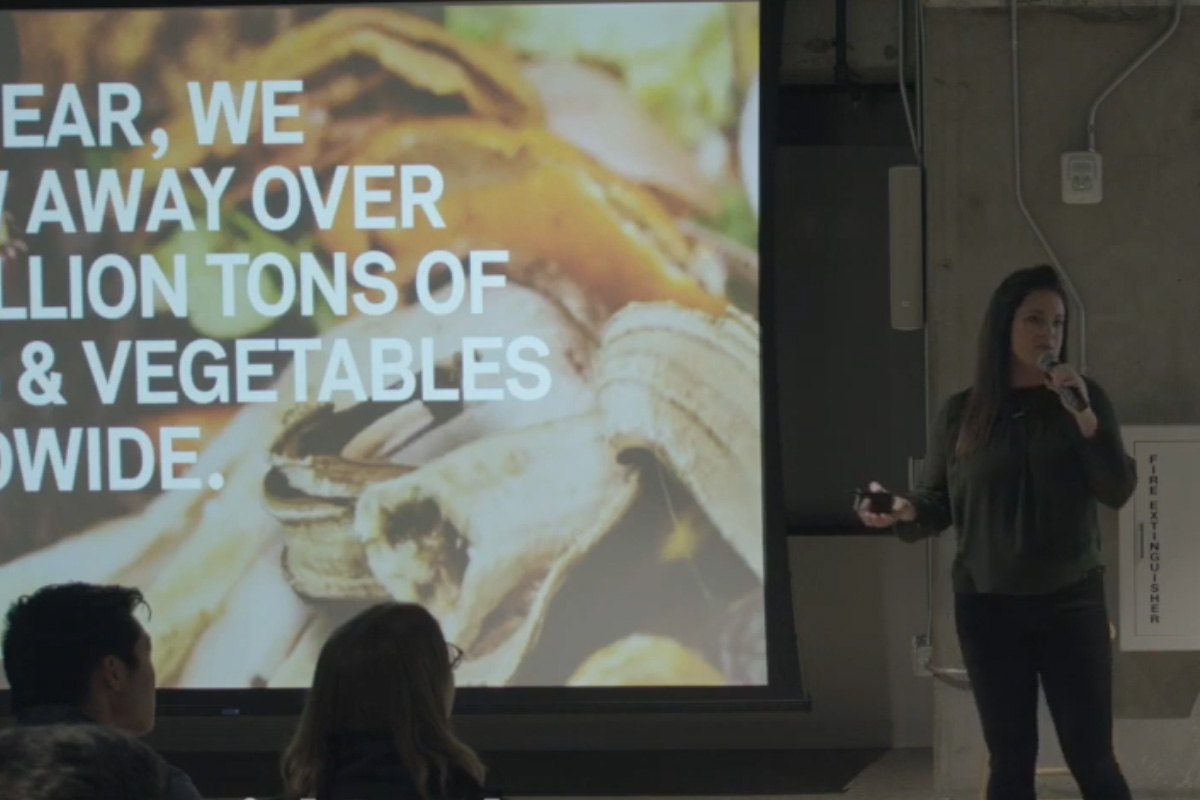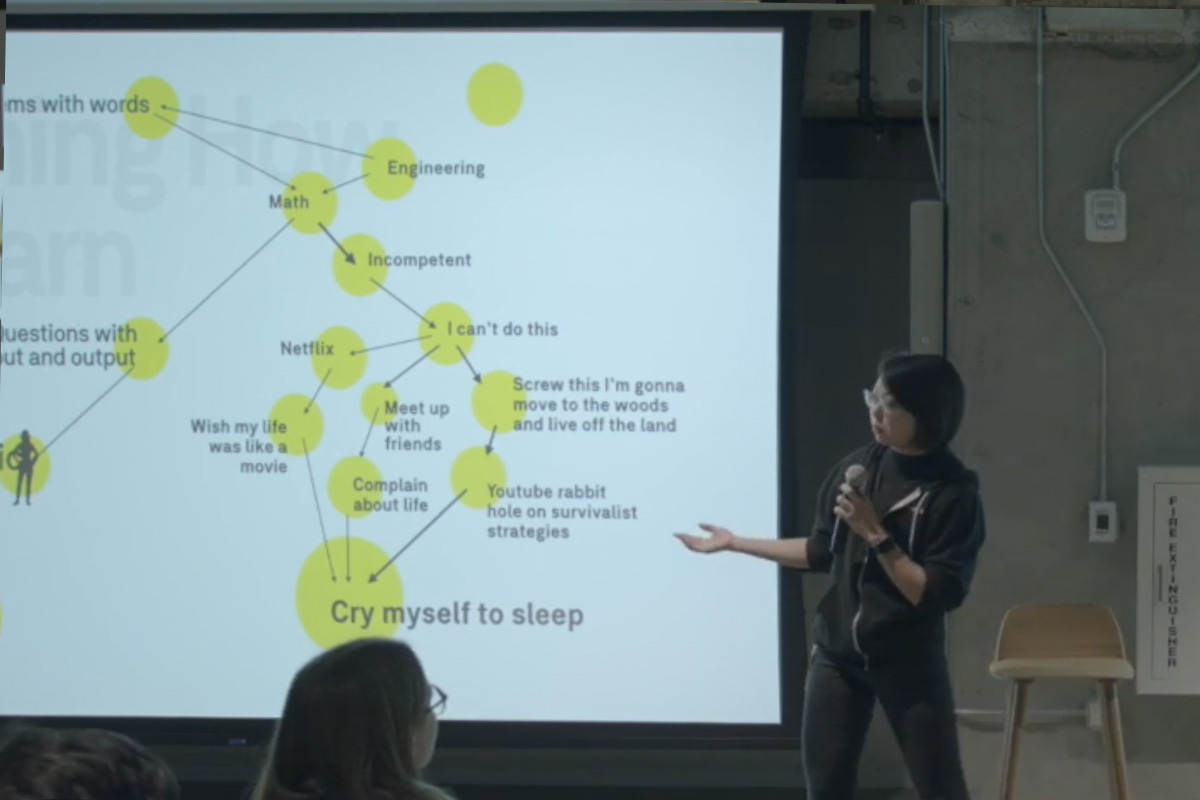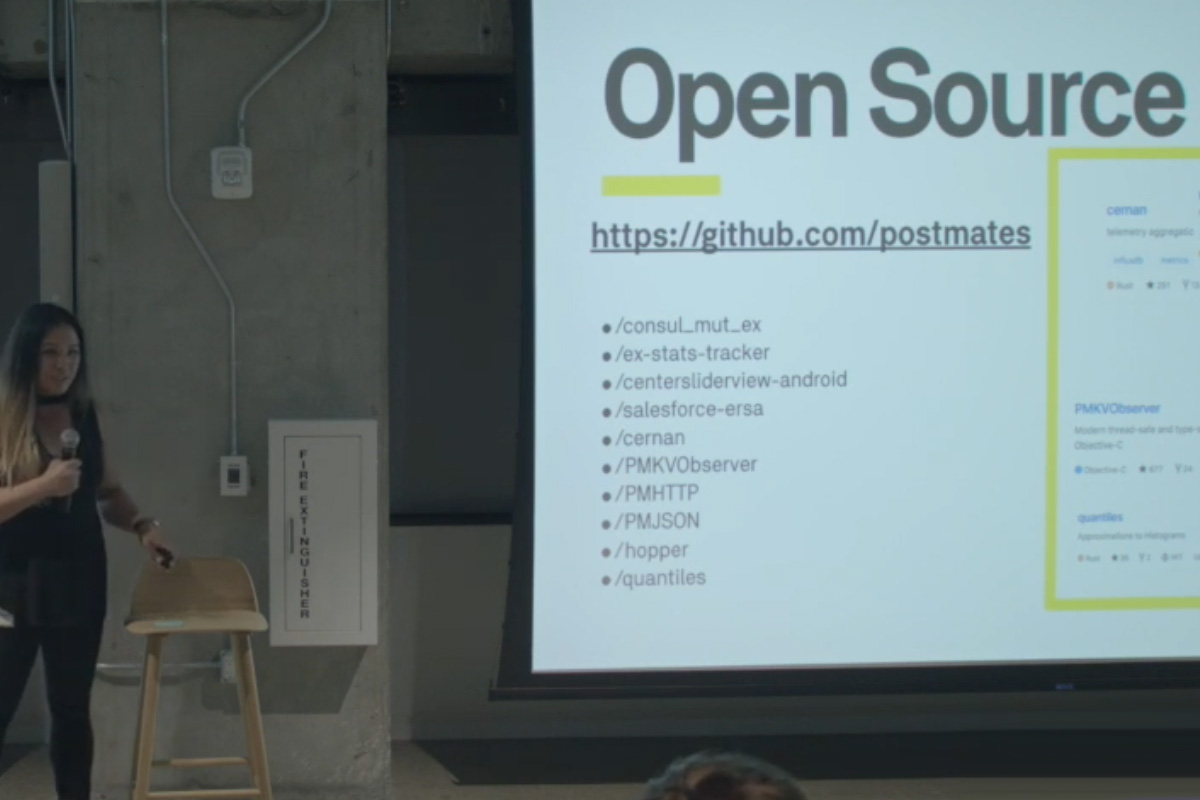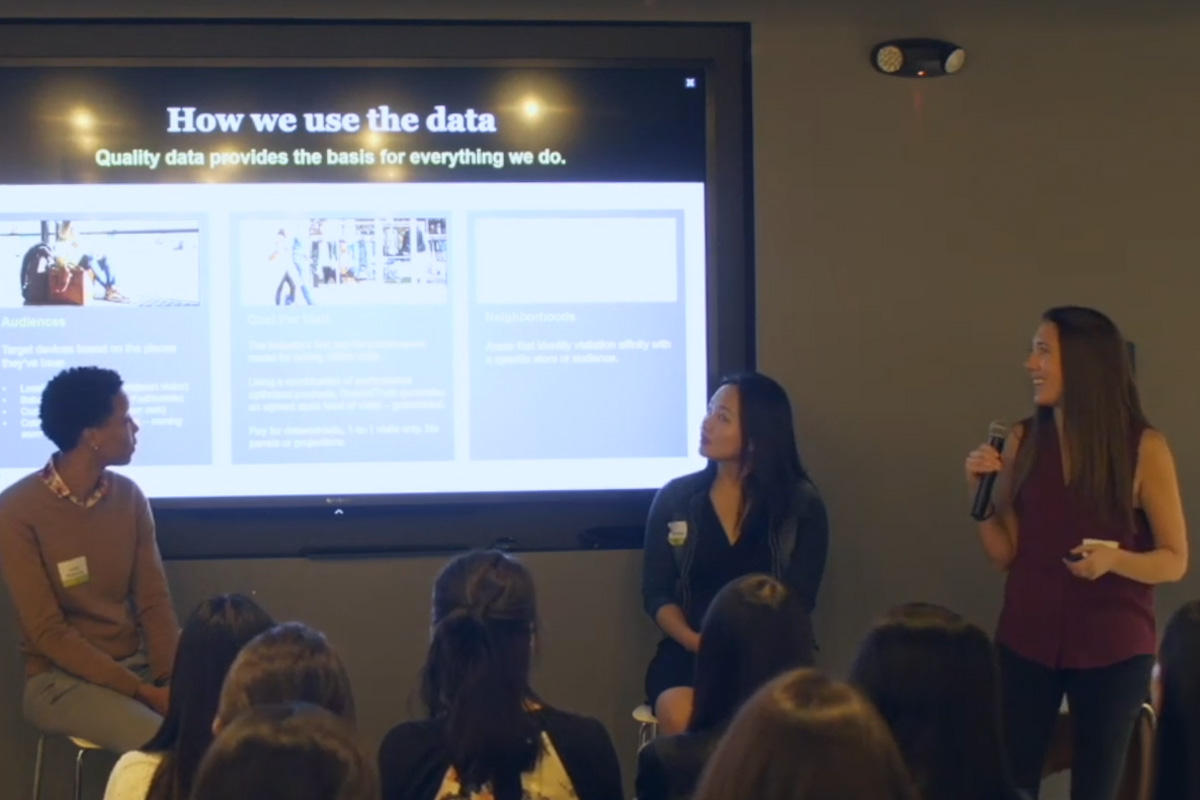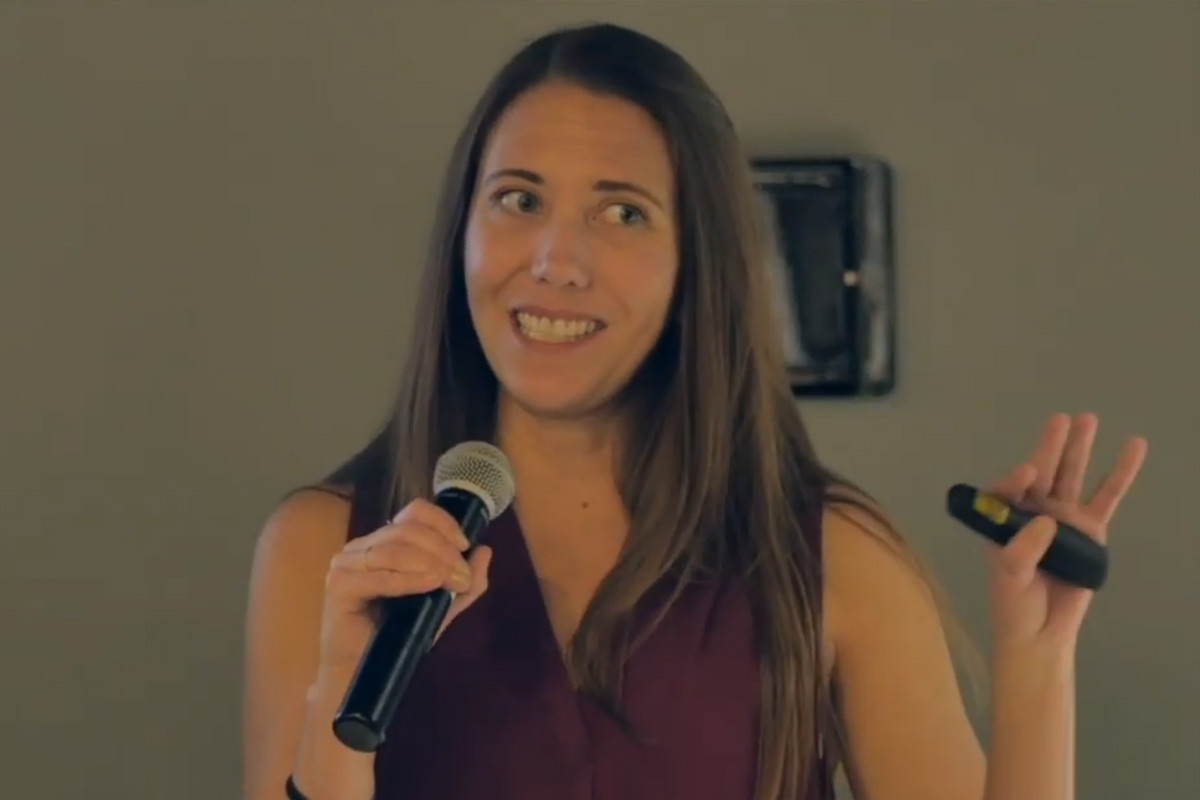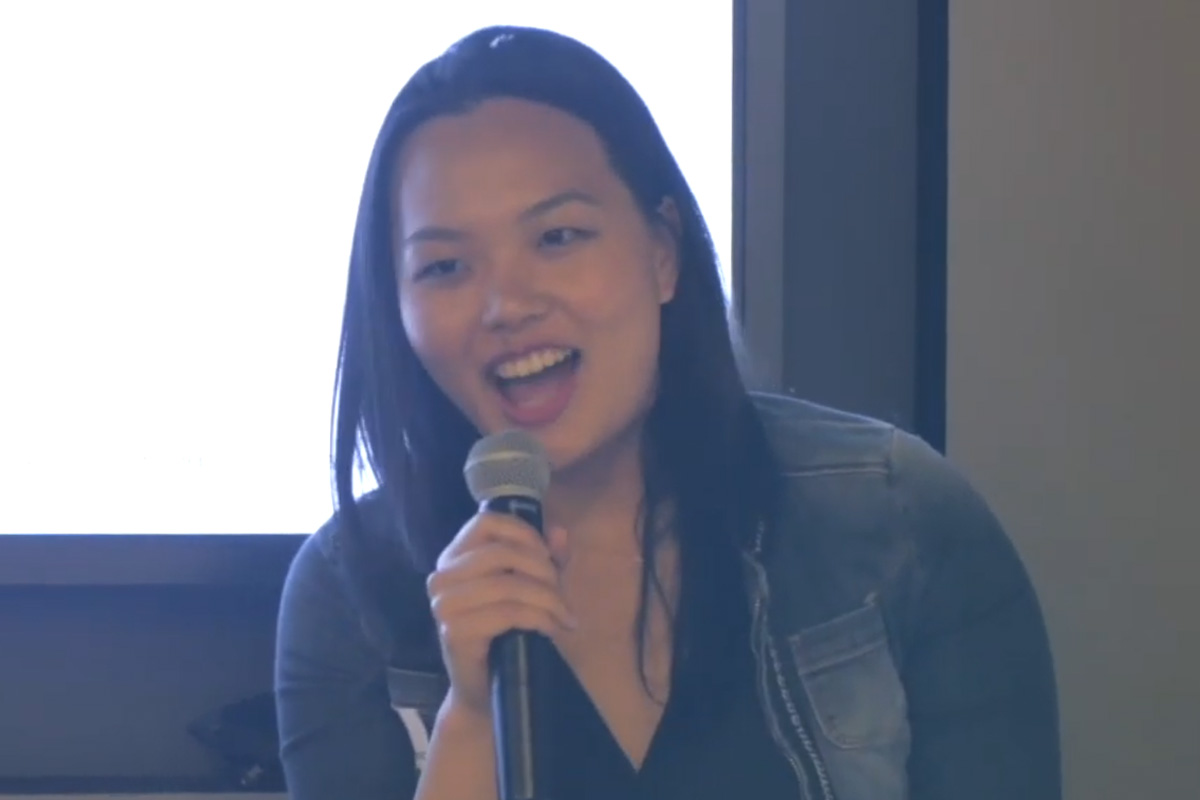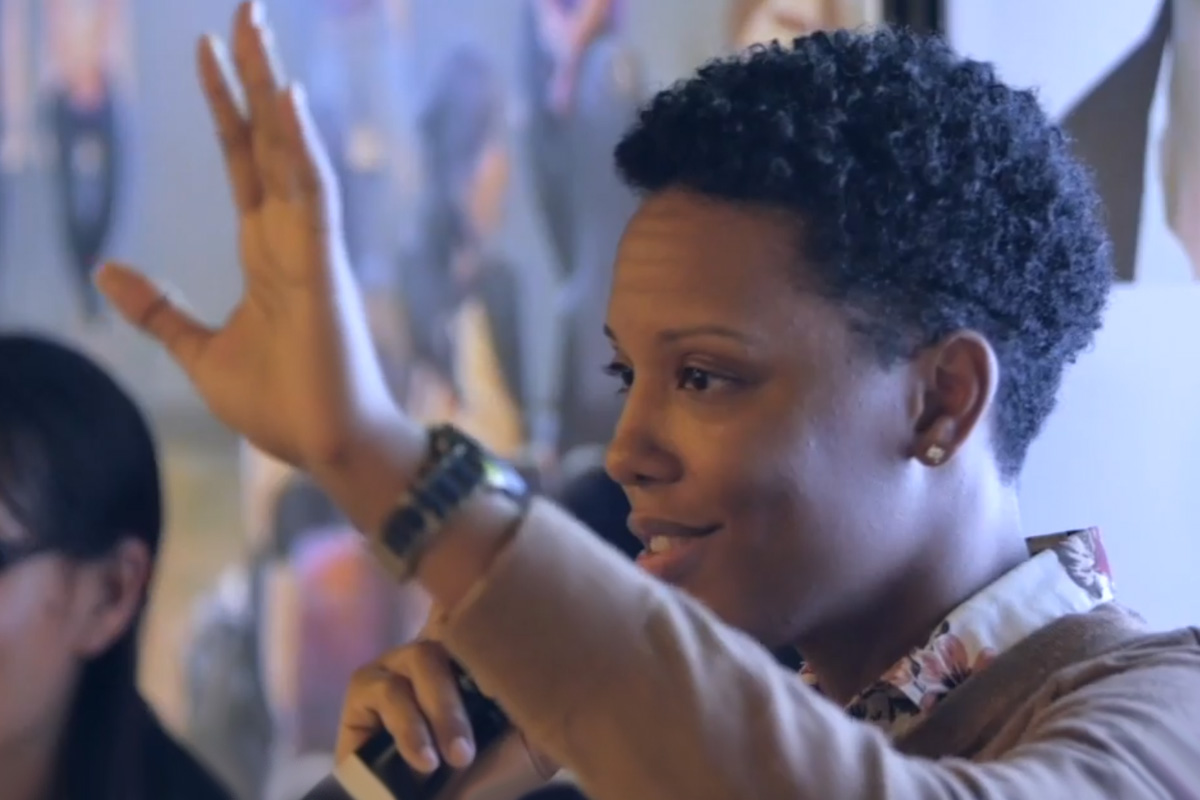Like what you see here? Our mission-aligned Girl Geek X partners are hiring!
- See open jobs at Blend and check out open jobs at our trusted partner companies.
- Does your company want to sponsor a Girl Geek Dinner in 2021? Talk to us!
Speakers:
Laney Erokan / Internal Communications Lead / Blend
Priya Nakra / Product Manager / Blend
Ashley McIntyre / Manager, Sales Engineering / Blend
Eunice Noh / Product Design Lead / Blend
Crystal Sumner / Head of Legal & Compliance / Blend
Angie Chang / CEO & Founder / Girl Geek X
Gretchen DeKnikker / COO / Girl Geek X
Transcript of Blend Girl Geek Dinner – Lightning Talks & Panel:
Angie Chang: Hi, I’m Angie, founder of Girl Geek X and welcome to Girl Geek Dinner at Blend. I’m really excited to be here. I’ve always walked by on Kearny and wondered what Blend was so I’m really excited to be in this space and hear from the amazing women here at Blend.
Gretchen DeKnikker: All right. I’m Gretchen. How many of you guys, this is your first Girl Geek Dinner? Oh, good amount, so we do these every single week at a different company obviously. We’re also doing on Friday, which is International Women’s Day. If you haven’t figured out a way to make your company buy you lunch, you have less than 48 hours to make that happen. We’re going to do an all day virtual conference. It’s going to be awesome, like amazing topics, technical talks, things on intersectionality, and systemic change, building high performance teams. All the stuff that you love from the Girl Geek dinners that will be personally curated. It’s like a Girl Geek dinner on steroids. You definitely want to come, and there’ll be video later. We also just released episode 5 of the new podcast, which is on … No, just like every channel.
Gretchen DeKnikker: It’s on mentoring or imposter syndrome or something. Anyway. There’s five of them now and so, check them out because we take stuff from the dinners and then, we add our opinions, of which we have many, onto them. They’re fun and give us feedback too because we’ve never done a podcast and they might totally suck. It’d be really cool if we learn that fast. All right, so we started doing this new thing. This will be the second week and who won last week cannot do it again. Okay, so if you’ve been to five Girl Geek dinners, raise your hand. Six, seven, eight, you can’t win again, nine. All right, you win. You get Girl Geek socks. Hold on. I have them right here. Oh, shit.
Gretchen DeKnikker: All right. We’ll get the other one. We have more socks but don’t kill Angie on the way out for them. Okay, so we’re excited for this especially the food, the dumplings were amazing. We ate them all. Thank you for coming and enjoy.
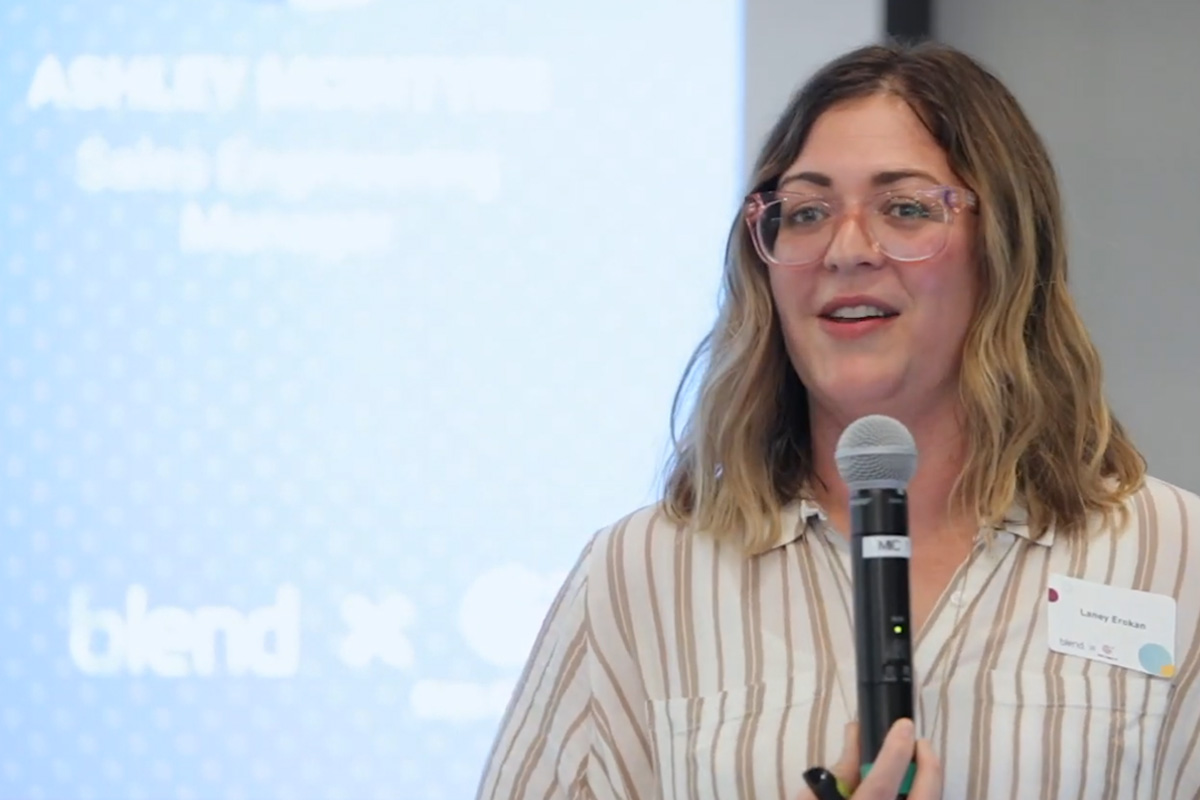
Internal Communications Lead Laney Erokan welcomes the sold-out crowd to Blend Girl Geek Dinner in San Francisco, California.
Laney Erokan: Thank you. Thank you. Thank you. Clicker. Hi, everyone. How you doing? I have something really exciting news to start with. There are two seats right up front. If you want to sit down way up close. There’s two seats and one there. Feel free to mingle around. My name is Laney Erokan. I run internal communications here at Blend. We are thrilled to have you here this evening. You’re going to hear some really great stories from my lovely ladies up here who I’ll get the pleasure of working with. If you don’t know Blend, we’re a software company that we partner with some of the world’s largest financial institutions like Wells Fargo and US Bank. We make it easier for people to get loans. That’s Blend.
Laney Erokan: I joined Blend two years ago this month. I wanted to come somewhere where I could build something special and I was ready in my career to go to a place where I could build out what I was going to do. I wanted to find out a way to help this really cool company work on their internal communications and the opportunity was too good to pass up. I made some errors. I had some wins but there was a really cool thing that I got to be a part of, which I think you only get to do when you’re at a company of about this size. I got to work with our executives and our founders on creating this cool book, called our Beliefs Book. When I joined, we had just rolled out our principles for the first time.
Laney Erokan: The company was four years old. I was the 120th employee. I just happened to get here right at that time. They said, “Well, you know how to write. You know to talk. Let’s take this and do something with it. Over the course of two years, we took our company principles and we refined them over and over. We did that in a couple different ways. We took input from employees. We had focus groups, had a Slack channel called Principles where you could drop in ideas or articles. You could create a web form where you could put any suggestions you might have about our principles of how we work together. Every quarter, I sat down with our founders and we reviewed the changes and we implemented them or we said, “Well work on this.” It was a really cool process.
Laney Erokan: Then, last year, they said, “Let’s make this a book.” I spent the last year sitting in a conference room with a variety of people, taking our principles and making them into a narrative. It’s called our Beliefs book. It was a really cool opportunity that if I was at a much bigger company, I wouldn’t have been able to touch them because they would’ve been written in stone on a wall somewhere. I got this really cool opportunity. That’s cool things that we get to do here at Blend. Anyways, this is a great place to be. It’s a great place to work. You’re going to meet some of my favorite women tonight.
Laney Erokan: A quick housekeeping note, we would love for you to ask questions but I ask that you hold them to the end. We’re going to have microphone runners and all of that at the end, but please hold them until all four people are done speaking. That’s it. On with the show. I would like to introduce our first speaker, product manager, Priya Nakra to share some experiences from the many different hats she’s worn here at Blend.
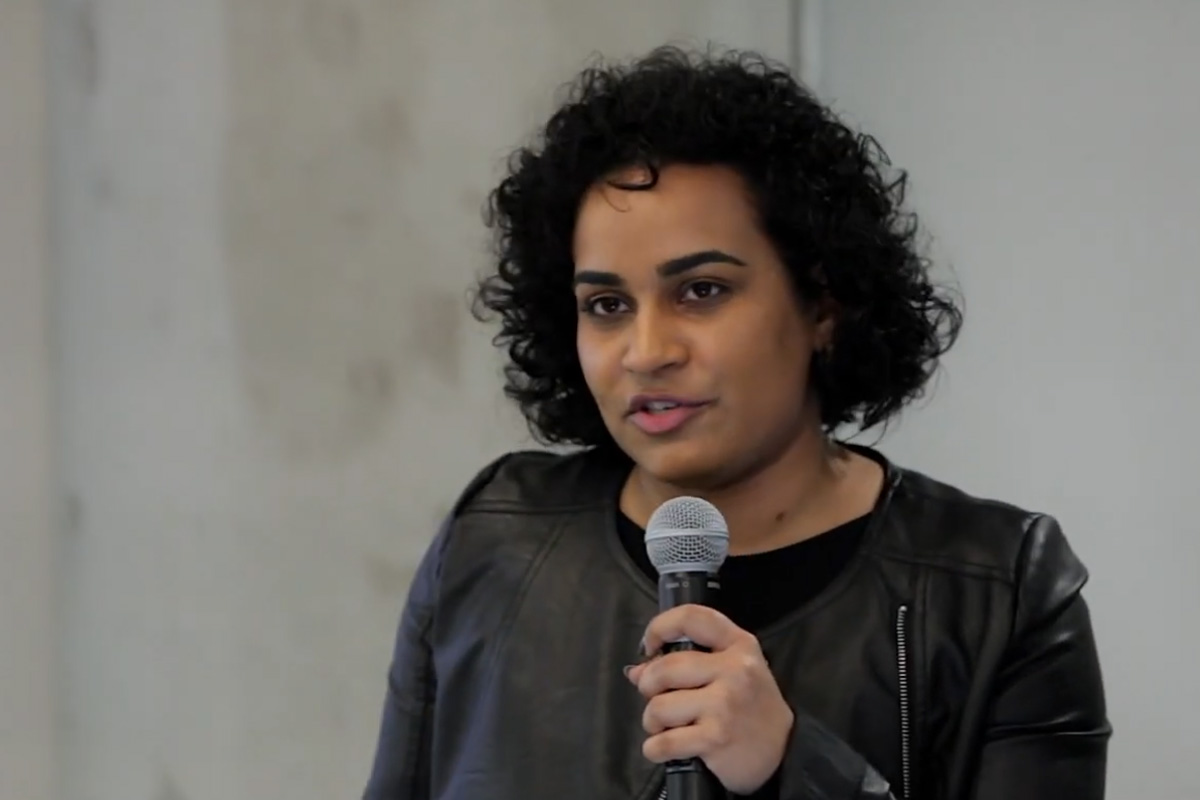
Product Manager Priya Nakra gives a talk on making the case for the work you want to do at Blend Girl Geek Dinner.
Priya Nakra: Awesome. Can everybody hear me okay? Good. Great, great, great. Cool. Thank you. When I was first asked to speak at this event and by the way, I think other people are starting like that but since I’m first just to pretend I trademarked it. When I was first asked to speak at tonight’s event, I was shocked and honored but also incredibly terrified. Not incredibly terrified in like the typically sense, “Oh, I’m scared to talk in front of a big group of people.” It’s more like terrified that on this panel of illustrious women, I would definitely be the speaker who was definitively less qualified. That’s the thing about imposter syndrome is that it hits you the hardest when the proof is literally right in front of you that you don’t need to feel like an imposter.
Priya Nakra: Still, it retains. It persists and it haunts you. Between this and having to write a blog post for the Blend website, shameless plug, it goes up next week. I even asked our content marketing team. I said, “Isn’t this too much? Isn’t this too much me talking about myself, my career? Aren’t people going to think I’m really full of myself?” I asked myself why am I doing this? Aren’t I opening myself up for scrutiny that I don’t really want? Isn’t everyone going to realize I don’t deserve to be here and that I’m a fraud?
Priya Nakra: My career at Blend has been a total whirlwind. Full of ups and downs, total roller coaster, full of moments and memories where I felt like the most qualified person in the room to when I felt like I could be fired tomorrow. All in a day, by the way. There are days when it feels like success just means survival. Just getting through the day. There are days where success means winning the competition and exceeding your own expectations. Then, there are days when you realize how much you’ve grown, how much you’ve learned, and proven to yourself that you are capable and worthy. Those are the days when I remind myself of where I started here at Blend.
Priya Nakra: The feeling I have on those days of accomplishment, and hope, and growth. That feeling and that realization is one of the reasons I’m really excited to speak to all of you today. How many of you have ever heard this phrase by show of hands? Anyone? How many of you have told yourself this phrase? Cool. Something in common. See that’s shared interest here. Okay, it took me a while to understand but being called technical is a spectrum. It means completely different things to completely different people all across industries. I had taken coding classes in school because my major was industrial engineering, but when I went to my first job in corporate consulting, you are either marked as functional or technical.
Priya Nakra: There wasn’t really anything in between. I was told by my manager several times that if I wasn’t learning how to code or actively with the engineers looking at code and debugging things or drawing systems architecture diagrams for our customers, I wasn’t technical. After four and a half years on the functional project management track, it was too late to try and be technical. That’s what I told myself when I joined Blend as well. Much to my initial chagrin and eventual appreciation, the deployment lead job that I took at Blend almost two years ago led me to our largest enterprise customer, which is Wells Fargo, who also happen to have the most complex and antiquated integration points.
Priya Nakra: I didn’t really have a choice but to at least learn the basics of how Blend could talk to other systems and their architecture in general. I started with a bare minimum. Understanding what systems Wells had. What systems we had. How we pass data from one system to another in order to support the process of the cycle of a loan. Then, I dabbled a little bit into air handling, alerting and monitoring, debugging some critical issues. It was essentially the equivalent of me tepidly dipping my toes into the really vast seat that is the technical world. It was at this time and during this project that our head of technical integrations, Irsal Alsanea, who’s also our only female engineer and group lead. She and I were sharing a glass of wine in sunny Des Moines, Iowa when we were at the Wells Fargo office.
Priya Nakra: We realized that we have these really symbiotic complementary strengths. She had a team of integration engineers who needed a lot of structure and I could provide that with my functional project management and in turn, I could learn a lot about what it means to manage technical products. It’s because of this and because of where Blend was as a company, she and I created together this enterprise integrations program manager role where I could, again, learn more about being technical and also provide a lot of structure for engineer. I’m extremely grateful that she took a chance on me on this and elevated me to the next level.
Priya Nakra: As the program manager for Blend’s enterprise integrations, I was managing all of our productized integrations with loan origination systems and CRMs. As well as managing any customer request. I know this is really riveting, bear with me. It was the first time I had any experience managing a technical project but I really did rely on my functional experience to provide some structure to the engineers. Things like helping them with capacity planning, getting better requirements on their tasks. As well as fielding any questions from customers and customer facing teams, so that they could focus on the actual code and development. During the initial stages of the role, I was pretty consistently overwhelmed every time I had to get on the phone or talk to a customer, partner and explain to them what it was like to build against our APIs and all the requirements that they needed.
Priya Nakra: I was pretty well prepared. I was doing my research on the side. I made a running list of engineering terms and added to it every time I heard a new one. Still haven’t quite figured out polymorphism. Don’t worry about it. It’s fine. Stack Overflow and Techopedia became my best friends and confidants. In the real time pressure of talking to engineers who at least acted like they know more than I did, it was really easy for me to doubt myself and shut down a bit throwing all my confidence I had and my skills out the window. It was at this time I again had a really lucky opportunity to work for Kelli Scott who is our head of services and support. She runs our professional services division. She was the perfect manager for me at the time because for every customer conversation that went awry or any bad experience I had with an engineer that made me feel less than, Kelli was always there to illustrate to me that I was capable.
Priya Nakra: That really, I just needed to focus on those muscles that I hadn’t been flexing before. Muscles like empathy for the end users and the developers who are building against our APIs. The folks who I was interacting with when were building these tools and also a keen eye on business process optimization. Most importantly, the muscles she encouraged me to flex was patience and empathy for myself. I remember a moment when during a particularly horrible partner call, after I admitted to the engineer on the phone that I’m not an engineer and don’t have quick access to the code. He stopped talking to me and calling me essentially a useless middleman, refused to speak to me any longer. Demanded to speak to one of the engineers on my team.
Priya Nakra: I was crushed, understandably. All this hard work had come to a halt. With Kelli’s help and mentorship and the lessons that she gave me, I put myself in the shoes of this particular engineer who himself was on the hook for delivering something to his boss. I also gave myself the time and the patience to ramp up on concepts I hadn’t been familiar with. Hopefully, the pattern is becoming clear in my career that with every new opportunity, every open door, I had a chance to learn something and push myself out of my comfort zone and prove my capabilities to other people and most importantly myself.
Priya Nakra: As I started gaining more confidence in the program manager role for integrations around Q3 of 2018, Blend’s first female product lead, Blair Martin also joined the company. She managed all integrations-related product builds. I remember even the first time we met, and I walked her through what I did on a day to day basis, how many customers I was the main point of contact for, how many integration patterns we scaled from one to many customers. Even on first meeting, just that first interaction, she said, “You’re already doing the job of a product manager, why aren’t you one?” I remember being really surprised but also quietly validated. The term product manager is a highly coveted position in the tech industry.
Priya Nakra: In the back of my mind, I was always wondered, could I be a good PM but surprise, surprise didn’t have the confidence to actually campaign for that position. I also told myself it was a far departure from what I was doing, I again wasn’t technical enough. Didn’t have the engineering resources or the chops, had never shipped a product. The excuses were endless as were the reasons to doubt myself. Between Blair’s product management leadership and her passion for growing PMs, especially new PMs and the work I had already done, managing multiple integrations and creating tooling and processes for other engineering teams to leverage, it became clear that the next step for me was to make my case to join the product team officially.
Priya Nakra: With Blair’s help and the consistent advocacy from people like Kelli, Irsal and other folks in the engineering and product org, I was able to step in to the PM role officially in September of last year. Since then, I’ve been able to launch internal and external tools, and truly build products that were API first. During my career at Blend, I’ve been incredibly lucky to find a circle of women who empowered me and believed in me, even and especially when I don’t believe in myself. This feeling and realization is also one of the reasons I volunteered to be the chair of our employee resource group, Women at Blend.
Priya Nakra: I realize if it hadn’t been for the people at Blend and primarily the women at Blend who believed in me during my time here, I wouldn’t be in the position I’m at today. I wouldn’t have had the opportunity to grow exponentially throughout my career. This made me really want to create these opportunities for other women at Blend and starting ERG-led initiatives like cross functional development, and mentorship sessions, I hope that I was able to help other women in Blend find another person or another circle to empower them. At the risk of sounding basic AF, the power of a girl squad is real and I wouldn’t be here without mine. Thank you.
Laney Erokan: Thank you so much, Priya. I love that story. Our next speaker is sales engineering manager, Ashley McIntyre. She’s going to take you through how she defined her career path and some counterintuitive lessons she learned along the way.
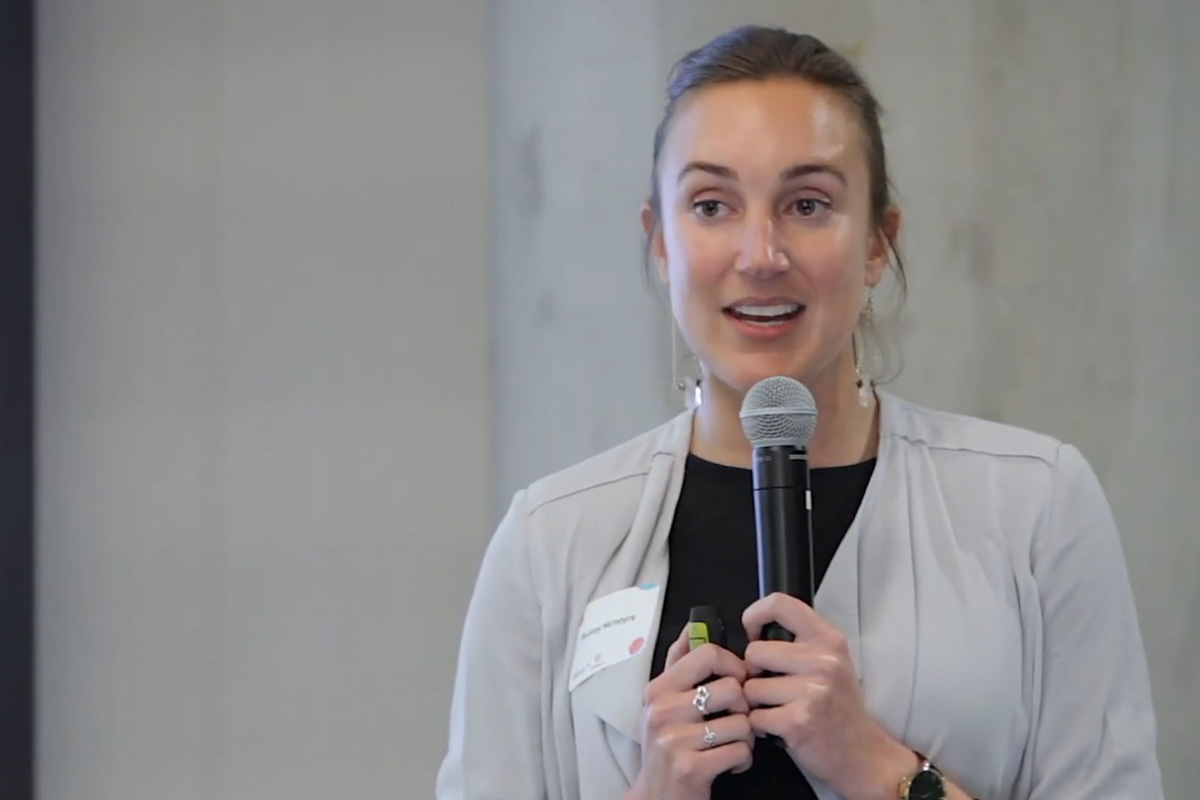
Sales Engineering Manager Ashley McIntyre gives a talk on finding your niche by identifying your strengths at Blend Girl Geek Dinner.
Ashley McIntyre: Thank you, Laney. Nervous. As I started preparing and really thinking about this event, and once we got the marketing material out there and I sent the Eventbrite link to a couple friends in the last two days. I didn’t want to advertise it too much lest they make too nervous. I kept coming back to what I had helped write in the description, which was Ashley’s going to talk to you about how to be what you … or how to figure out where you want to be when you grow up. Then, I realized I actually have no idea how to answer that question. Maybe I signed up for the wrong thing. The last time, I knew what I wanted to be when I grow up, I was five. I wanted to be an engineer.
Ashley McIntyre: Starting out an engineer, became an engineer but I wanted to be an astronaut. How do you tell that face that she’s not actually going to know what she wants to be when she grows up, but it’s going to be okay. Well, jump to the end there, I don’t know what I want to be and I have never had a dream job that I’ve been aiming towards as I go towards this path. I realize that a lot of times, people come to events like this and you hear these amazing stories of all the successes people have had but it’s hard to relate to those. It’s hard to say, “Oh, yeah. I can probably get there one day.” When I thought about this question and what I wanted to talk about, I realized that it might be more interesting for you all to hear about all of the nos. When I look at what actually ended up stringing my career path together, it is those nos that had a profound and positive impact on me but I didn’t realize that at time.
Ashley McIntyre: I want to share a couple stories with you all tonight about what that means and how I got here. To go back, my final year in college, I was coming out of an engineering degree at Berkeley and I couldn’t get a job. I went through on campus recruiting along with all of my peers and especially in that fall semester when you’ve got all the big companies who are hiring. I was in all of those meetings. I went to the career fairs. These jobs sounded amazing but I applied for all of them, and I got one call back for which I went to one interview, for which I got zero response. I didn’t even get a no. To the recruiters in the room, when you say no and actually formally end that relationship, it is so much better than you never getting back to us. I can tell you that.
Ashley McIntyre: That was hard. It raised a lot of questions for me as my peers were going into their spring semester with a job and I was trying to figure out if I’d ever be able to live in San Francisco and move across the bay, and achieve this dream. That question of am I capable? Do I have a path? I’m standing here at the edge of this cliff, what’s going to happen when I jump off in May was really hard to answer. I get to the very end. I get to April. I’m graduating in May and I end up taking the only job for which I got an offer. Hey, at least it was money. What that job was is I was commuting from Berkeley to San Francisco for a 6:00 AM shift to cold call people in New York and Pennsylvania, who would hang up on me if I couldn’t articulate myself in 45 seconds or less.
Ashley McIntyre: What that job turned into was something I never thought, especially at that time, that I’d be able to achieve, which was I ended up running one of the largest, most complex projects at that consulting company. A funny little side story on that is when I ultimately did decide to leave and I told that client that I was leaving, they’d actually almost forgotten that I didn’t work for them, that I work for the consulting company. They tried to hire me on the spot. We just heard about Priya’s experience with imposter syndrome. That’s one of the things honestly that I think back on when I feel that, which is still daily today, which I had a company that I didn’t even work for try to hire me because they didn’t want to lose me. Sometimes you need those boosts, especially when you’re coming from a job paying you $40,000 and you’re barely making a living to live in the city.
Ashley McIntyre: How did I get there? When I got to the consulting company, I leaned in. I worked hard. I did a lot of extra work and I made sure people knew Ashley’s name. I really try to do that by traveling and spending time in other offices. As I started working my way through the ranks, people started saying yes to me. There wasn’t that silence. There wasn’t that no. There was people who wanted to invest in my path. For me, that was one of the things that stands out as my first piece of counterintuitive career advice, which is sometimes, it’s better to stay than it is to go. A lot of times, you see people who are moving around from companies. There’s so many cool tech companies in the Bay Area and people tend to job hop a lot. A lot of times, maybe to increase their salary.
Ashley McIntyre: If you’ve got a company that’s investing in you, you’re never better set up for success than you will be with the rapport and the trust that you’ve built with them. Don’t underestimate those opportunities if they’ve shown that they’re willing to do that because every company is going to have their issues. In those four and a half years, I rose to a level that I didn’t predict that I’d ever have been able to and I don’t think I would’ve gotten those chances coming in without a record of trust. Coming out after that time, there did come a time when I wasn’t as excited about my path upward anymore. Then, I said no to the company. I decided it was time to look for my next job.
Ashley McIntyre: What I didn’t realize was that it was going to be back at the edge of that cliff. Another demoralizing seven months before I started that next job where I was sending out cover letters and resumes after my full time job, getting no responses. I had no idea if people were going to hire me for a job that I didn’t have. I was successful in my current role but I wanted to move to something else. That wasn’t defined at that time and nobody would even call me back for that. Where I struggled with that is I didn’t know how I was going to get my in. That came to my second piece of counterintuitive advice, which is sometimes that close work friend or your work wife leaving to go to another company can be one of the best things for you because that network may bring you on to that next challenge or that next role.
Ashley McIntyre: That ended up being how I got that next role. I’d sat down and started thinking about what I loved about my day to day job. I found that my planning sessions with my customer at the end of each year where we talk about the next contract, educating them as to the vision and how we could actually deploy these features and these products that they could use was one of my favorite things to do. That to me started pointing me towards sales engineering, sitting at the crossroads of people and technology. Then, when my friend reached out about the open sales engineer role, I went in there. I was so excited. I think both that warm referral and my interest helped lead me to get that job. Then, that company said yes to me.
Ashley McIntyre: I started at that job and a similar story here. I leaned in. I worked hard and I started seeing success. A year and a half in, I was gaining traction. I was put in a leadership role. I was going to have the opportunity to build a team for the first time, which was I so nervous about but excited about. Then, one day, I made a mistake. I made a huge mistake that ended up losing the trust of my colleagues and it ended up costing me my job. My company was going through some layoffs at that time and my mistake caused them to say, “You know what, you’re no longer a part of this team.” What have I done? The questions immediately sprung up, the shame, the embarrassment, the confusion, can I do this? Am I following a path? Did they just blow the bridge in front of me? What have I done and how am I going to get through this?
Ashley McIntyre: If anybody knows that feeling in the pit of your stomach after your breakup, when you hear your former partner’s first name and that knot opens up into a bottomless pit, that’s what it felt like for about a week. It was not pretty. I was scared. I did a lot of crying and I was really ashamed. It was really hard telling people that I actually had a role in this. I was really upset with myself. Then, one day about a week later, I woke up and realized I’ll be fine. I’m not going to let this be the reason that I say no to myself. I’m not going to cut off my own path here and I’m not going to let this lapse in judgment but learning experience stop me from continuing to learn from it. What I realized in that time and as I move forward is I realized that this time I actually had all the time in the world to find my next job, to find the next right thing. That’s what I started doing.
Ashley McIntyre: I sat down and I thought, and a couple things started coming to mind. The first was that I needed to capitalize on a job that had both a combination of strengths, and my interests where it played to those things, I knew that I would be the most successful, so I wanted to hone in on those roles. The second was even though I don’t think I am sometimes, I’m pretty darn smart and capable but my resume and my profile may not be what the sexiest, highest valuation tech companies or the biggest brand names actually want. That’s okay. Ultimately, I feel more at home as a big fish in a small pond rather than the other way around. Realizing that and really embodying it was one of the first times I actually felt the power of that because I kept judging myself when friends would talk about the coolest companies that they’re at.
Ashley McIntyre: Really, that didn’t mean they necessarily liked the culture of that company or felt motivated, or felt that they were in a place that they could grow, but they just had the brand name. I realized that that was going to be enough for me. I realized every time I saw rejection come up, it was quick to follow when I was focusing on other people’s strengths. I needed to focus back on my own. Ultimately, the challenges best suited to me where the ones in the environments where I was happiest and so, I started using those things as my guiding star throughout this job hunt. That’s not to say that that job hunt was easy either. There was 35 conversations that I had over two months as I tried to really expand my network and give it a chance. Then, one day, I found Blend.
Ashley McIntyre: I’ve been here for about two years now, which is crazy to me because as I look back at my opportunities here. I came in as an individual contributor on a small team of two people. Blend gave me a chance as a new manager last January and I now have a team of six that report up to me. I’m learning these new challenges as a new people manager but also in a growing company that you’ve heard a little bit about here. The reason that I came here was not because I thought Blend had a chance of being a name brand. It wasn’t for any reason other than when I interviewed with this team, I thought I saw those core values of mine reflected back at me. That wasn’t something I wanted to ignore. I leaned in and even though each time, I left the interview process asking is mortgage even interesting? Do I want to do this for another five years? Because that’s what I wanted. I wanted to go somewhere where I could be there for five years.
Ashley McIntyre: Ultimately, even though I wasn’t sure if everything was going to be perfect, those values and the people were what I knew I needed to invest in this time around, which brings us here. In summary, I wanted to go back to the woman standing at the end of the cliff when she was leaving college, and not sure what she was going to do. If I had to summarize a couple things for her to take with her on this journey from what I’ve learned, what I’d try to say, though I honestly don’t think she’d listen to me knowing her insecurities as well as I do. The three things are there are benefits to be had personally and professionally to grinding it out at a company for a few years. Getting a lot of experience, taking roles that you didn’t think you would take when you first start at that job.
Ashley McIntyre: Invest in those companies when you can because they’re investing in you. Second, is embrace every no along the way and cherish those yeses. When you hear the yeses, celebrate them and keep working your ass off. Third, just because you may not feel like you have a path today, you may not have a dream job. You may not know where you are in your journey, doesn’t mean that somebody won’t one day ask you to get up in front of a large group and have you fail miserably at answering the question, what do you want to be when you grow up? Thank you.
Laney Erokan: Thank you, Ashley, so much and I’m so glad you said yes to Blend. All right. Next up, I like to bring up our product design manager Eunice Noh, who not only is going to talk to you about her career choices that she’s made along the way, but she also was the third woman hired at Blend. I think that’s really cool. About four years ago, she joined the company and she’s learned a lot in the meantime so here we go.
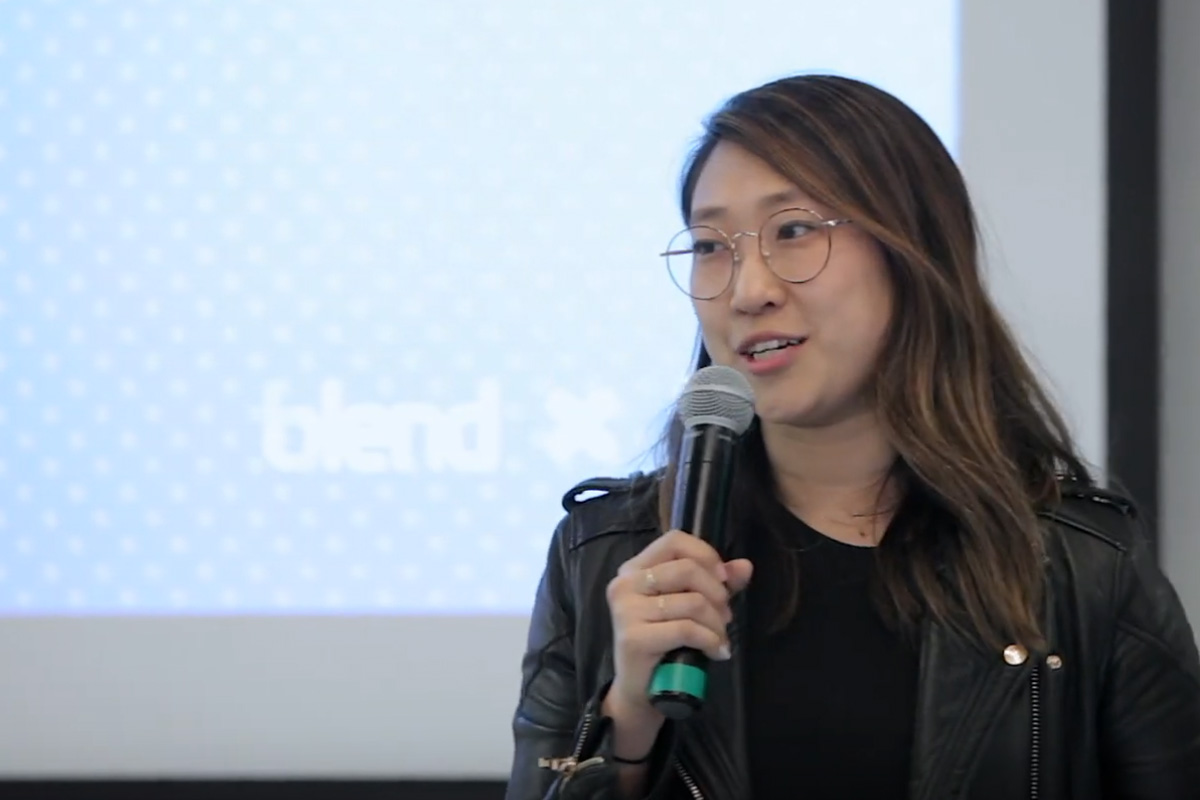
Product Design Lead Eunice Noh gives a talk on how thoughtful design can drive collaboration throughout company stages at Blend Girl Geek Dinner.
Eunice Noh: She’s going to help me progress my slides because I have notes in my hand. Well, I’m grateful to be able to be up here sharing my story. Honestly, if you asked me 10 years ago, if I would be up here and have the opportunity to speak to all of you, I would not have thought this would be a reality. Thank you all for being here. Different from Ashley, from a young age, I knew I wanted to be a designer. I probably did not know what that actually entailed and one of my school assignments in middle school, and I’m sure if any of you had this as well was to write a letter to your future self. That letter would actually be mailed to you after you graduated high school.
Eunice Noh: When I received mine after I graduated, I’d completely forgotten what I had written and was pretty surprised that I said I wanted to be a designer. Not pretty surprised that I wanted to have two dogs so two out of three so far. Working on the second dog, trying to convince my fiance right now to get one. He’s not down. One of the things that stuck out to me most in that letter was the last thing I wrote to myself, which was don’t be too hard on yourself. I think I was a pretty wise kid actually. It made me realize that I struggled with self criticism at a very early age. When I was preparing for this talk, there’s about four moments in my life that stood out that I realized that the common thread in each and every moment was that I was really out of my comfort zone while still struggling with self doubt and self criticism.
Eunice Noh: The first one I’m sure most of us have gone through is going to college. There were a lot of thoughts leading up to that day, that first day. Am I going to like my roommate that I’m sharing a boxed room with? Am I going to make any new friends? How am I going to do this without my parents? Am I majoring in the right thing and so on. I was really nervous and scared already to start this venture. This is … actually, go to the next one sorry. This is a photo I actually found on my Facebook that while I was watching the news with my dad before starting college, it said top five useless majors. Just to clarify, I majored in fine arts with an emphasis in graphic design at USC. Not only did I have one but I had two up there.
Eunice Noh: Going into that, I was even more scared to start school. I really didn’t want to mess it up. School isn’t cheap. I really didn’t want to disappoint my parents and so, I definitely was in a little bit of a panic when I started. Reflecting back, I think I took a lot different, non-traditional path from most of my classmates and friends. During finals week, most of them were huddled in libraries studying for exams and I was huddled in the studio with paint all over my hands trying to finish my final art project in time. I think also too, a lot of them were getting internships to secure their careers. For me, I had … it wasn’t really that clear for me. Product design, how many people are designers out there in the room? Woohoo, okay. Just a few. Yeah, let’s stick together.
Eunice Noh: I think product design hasn’t been around for very long. It started in the ’90s but there’s so many titles. UI, UX, interaction, web design, and it didn’t really become well known until more recently. Also, in school, there wasn’t really a curriculum or a major that was really teaching us this experience as well. So I knew that I had a lot of work cut out for me to figure this out. I used internships mostly to figure out what I didn’t like. I actually had about six to eight internships while I was in college. Anything from fashion design, wedding event planning, and working for free for a lot of small startups. When I was going to school, free internships was a very common thing for most of us.
Eunice Noh: It wasn’t until I worked at a small startup as a web designer that I was really intrigued by the startup culture so I started spending a lot of my nights, instead of going out partying, drawing mocks of fake websites that I would come up with so I definitely don’t want to share with you those concepts that I actually worked on. After that, my final leap to my junior year, I heard about this new incubator program in New York that was hosted by General Electric and OMD, which is a small … I mean it’s not a small … an advertising agency. It’s a 10-week immersive program for 20 students who are aspiring to be entrepreneurs. I thought it wouldn’t hurt to apply. I honestly did not think I was going to hear back from them at all. I got selected so I packed my bags, moved to New York for three months before my senior year.
Eunice Noh: Again, so many self doubting thoughts the entire time leading up to the program. I was a broke college student in New York, barely turned 21 and this was the first time I had to interact with anyone that was over the age of 35. Now, that I’m older, 35 is very young. I didn’t know how to carry myself, what to wear, how to sound when talking because I thought my voice was too high. What to eat in front of them during lunch? I was honestly really nervous and frankly really scared. I woke up every day with butterflies in my stomach but also this uncomfortable pit in my stomach. You know, there was only one other woman in the program with me out of 20 and so, when I looked around and saw the men walking around, they had such confidence. Joking around with the execs, like seeming to have a really great time and not afraid to show their personalities. For me, I didn’t even know if I deserve to be there.
Eunice Noh: At the end of the internship or the actual program, there was a demo day where you had to pitch your idea. It was in front of the group of execs from GE and OMD. One of the requirements was that everyone had to talk. I wasn’t going to get out of that. My partner and I before we’re about to present, I threw up in the trashcan outside of the room. That was a really great start. To be honest, I really don’t remember how the presentation went because I’m pretty much sure I blacked out the entire time. But you know what, it was an exhilarating rush and I knew that I loved what I had and it was like a glimmer of hope for me that I deserved to be there. I realized though that I had one more year in school.
Eunice Noh: I decided at that moment that I wanted to graduate early. I’m sorry. I keep missing the slides, sorry. I knew I wanted to graduate early so I did everything I can to make sure I graduated in one more semester. After I graduated, I joined an accelerator program that led me to receive a seed round for my startup. They gave us the stability to build out our business. We hired two engineers and moved to San Francisco, which is where we are today. To be honest, I had a couple of years that I was in a very, very, very scrappy startup. I’m sure a lot of those few folks out there have experienced this. I found myself … actually, I missed a lot of Coachellas, a lot of Vegas trips. The struggle was really real.
Eunice Noh: At the time, that was really important to me. I was really, really bummed out that I wasn’t able to go on those trips. There was also a lot of really late nights till 4:00 AM but we were just figuring it out as we went. I was working on handling customer service, designing the product, teaching myself how to code so that we could have a working website. It was really hard to see if I was growing because we were learning on our own and everybody else that was around me was going through the same thing. We were just honestly just a group of new grads with zero experience running a business trying to run a business.
Eunice Noh: At the same time, still trying to figure out who we were outside of school. We were fortunate enough that we started to do pretty well, started to grow the team and we were profitable in two years. At that point, I was exhausted mentally and physically. At the time too, design didn’t really have a seat at the table. I find myself fighting for the value and importance of design and because I was the only designer, I felt like I was fighting for myself. Even though I co-founded the company, as well, I started to doubt myself and I convinced myself that I wasn’t right for the team, and ended up deciding to leave the company.
Eunice Noh: I wanted to make an impact, so again, having that seat at the table…. At the time, I thought product management was the only way you’re going to get that seat. I started to look for jobs in product management. Without even really thinking about if that role was right for me. Reflecting back, I learned two things. First, PM-ing is very, very hard, so shout out to all the PMs out there. I really appreciate everything that you do. Second, I realize that now I was trying to make myself right for this role for the wrong reasons. I wasn’t happy. I really enjoyed the parts of product management that was more around the experience and design. I thought if I just stuck it out that it would get better but it didn’t.
Eunice Noh: Also, in hindsight, the culture at that company felt like everybody was fending for themselves rather than working together. About after two years, I thought it wouldn’t hurt to look around and do what I love, which was product design. That’s when I was fortunate enough to work, come here, and work at Blend in the beginning of 2015. I’ve been here for about four years now. I remember my onsite at Blend, I thought I totally bombed the interviews so I called my boyfriend being like, “Well, that was terrible.” Had ready have made up my mind that they weren’t going to call me back. I ended up getting the job. When I joined, the company was still small. There was only about 30 people and I was the first woman hired in all of the EPD, which is engineering product and design team.
Eunice Noh: At first, it felt like everyone in this company really cared about what they were doing and the mission. It wasn’t just a job for them. Honestly, that was truly intimidating and motivating at the same time but I knew I had a lot to prove. People were taking so much time out of their day to onboard me and to make me feel part of the team, which is up here. This is actually a little bit further along when we’re about 60 people. Part of that was requiring us to run meetings on our own and to lead discussions. That was really scary for me. I was in fear every day that I was going to get fired, similar to Priya. I guess we’re all in it together.
Eunice Noh: One of the things that we had every Thursday was to do a design review in front of the entire company. Every morning on Thursday, I would wake up sick to my stomach knowing that I had to present in front of 50 people, which is now I’m presenting in front of more of you. This is … you know that I’m nervous. Speaking up in meetings was really hard for me. There is an analogy I like to use. I’m not sure if everyone feels this way but when I’m on a plane and I’d like the window seat, I think the entire time on the plane wondering when I’m going to use the bathroom. I’m like, “Okay, I’m going to go now. Should I wake up my neighbor? Am I going to get stuck in front of the beverage cart?”
Eunice Noh: By the time I convince myself that I’m ready to go to the bathroom, they’re like, “Seat belts, please.” You got to hold it for another 30 minutes. It’s not a good feeling. It’s really not. I think that’s similar in meetings. I work myself in my head and I’m trying to figure out exactly what I’m going to say and making sure that what I say is not stupid and should I talk now? Should I wait till the person’s finished his talking and a million other questions in my head. By the time I get the confidence to actually say something, the meeting has ended. Everyone’s already moving out of the room. It’s very vulnerable. I was very, very, very vulnerable. Luckily, different from any of the past companies I worked for, I had a great support system through my manager and then an outlet to talk to a lot of women during our Blend ladies’ night out. Having people to help build that confidence and give you those light nudges and support from people around me.
Eunice Noh: I’ve been a manager at Blend now for about two years and did not previously think I wanted to be one. I told myself that it wasn’t for me, that I wanted to be an IC and my manager really told me multiple times to give it a shot and that I would make a great manager. That was I was the right person for the role. I didn’t believe in myself at the time but I’m so grateful that I had someone that did. I find it truly rewarding now to work with incredibly amazing talented designers and see them grow. As manager today, I strive to be like my manager to give support and help build confidence for every single person on my team. I’ve realized that building confidence differs per person, that being thrown into the deep end might not always be for everybody.
Eunice Noh: I still struggle with self criticism and self doubt. I know that it’ll be something that I deal with for the rest of my life. It’s really easy to be your own biggest critic and when in the moment and working but looking back at the past 10 years, I’m grateful for all the experiences and people that had been part of my journey that have shaped who I am today. To end, if I were to write a letter to my future self today, I think I would remind myself of a few things. First, you can’t do it alone. We need to support one another. I see it time and time again, women being more harsh to other women but it’s a responsibility for us to support each other. Second, vulnerability is a strength and not a weakness.
Eunice Noh: When you hear that voice of insecurity in your head, just tell them to shut up. Vulnerability might make us feel less confident but I actually believe it’s our greatest mark of confidence. Third, simply do what you love. We’re fortunate enough to live in a world in the tech industry that people support what you want to do and your actual development as well. Fourth, I’ll take from my eighth grade self, don’t be so hard on yourself. Thank you.
Laney Erokan: Thank you, Eunice. Is it good? [inaudible]. All right. Well, I’m getting on a flight in a couple hours and I’m definitely going to think twice about where to sit because I don’t want to wake up my neighbor. Our final speaker of the evening is Crystal Sumner, who’s our head of legal and compliance. She’s going to come up and talk to you a bit about her career in the legal profession.
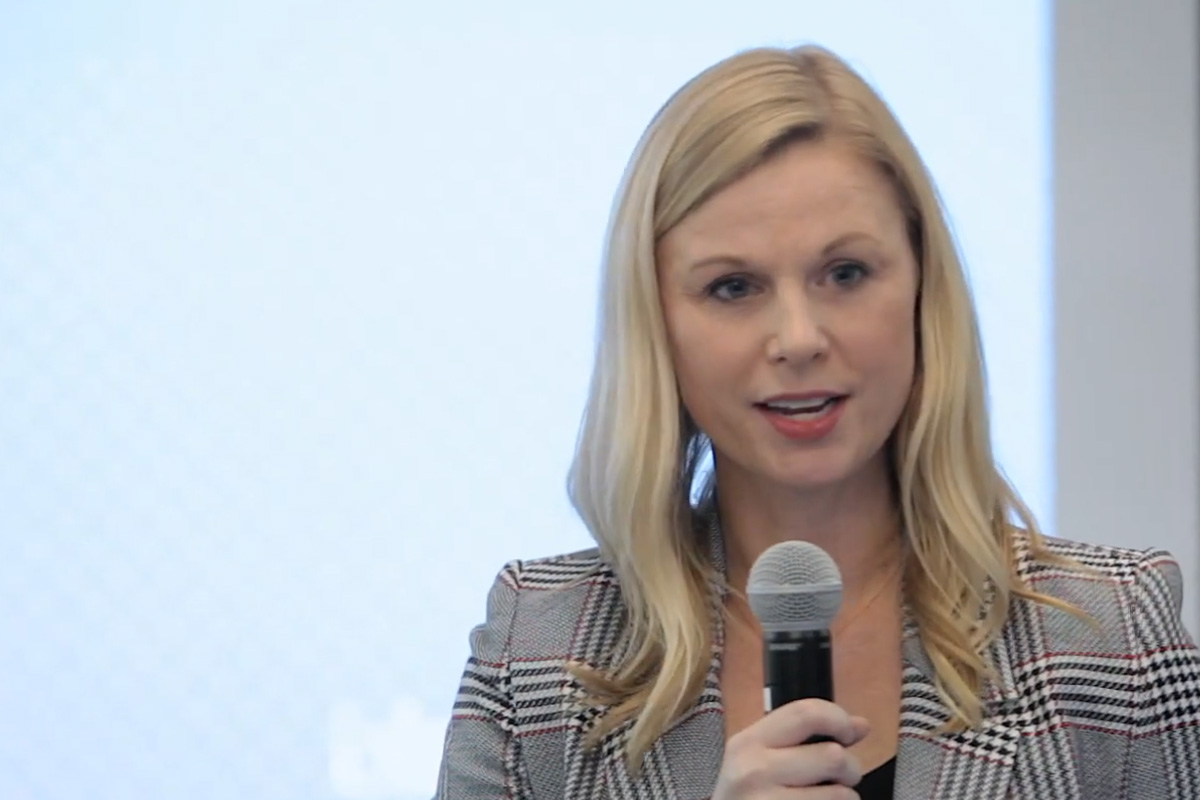
Head of Legal & Compliance Crystal Sumner gives a talk on taking action to create a more balanced workforce at Blend Girl Geek Dinner.
Crystal Sumner: Hi everyone. Super thrilled to be here tonight. To start the same way that Priya did, when I was asked to speak to everyone tonight, Sarah came up to me and she’s like, I really want you to say … give the inspirational ending. She’s like, “You’re one of two female execs at Blend. I’m sure you have lots of words of wisdom for people in the room.” Maybe it had been a really long day, maybe another depressing news cycle, I turned to her and I was like, “Can I just talk about why we’re not there yet?” She was like, “Sure.” I sat down and when I went to write this speech, it was like, “Well, that’s really A, not very inspirational and two, not very helpful.”
Crystal Sumner: When I started thinking about where there was lots of things basically where I grew up, the steps that I’ve taken, the mentors I’ve met, my support system that I actually do think have helped me get to the place I am today. While, I will always say there’s still a ton of work for us to be doing to advance women and represent minorities in the workplace. I think there’s definitely some tools–very practical as a lawyer–that we could all have to help us progress in our career. I grew up in Texas and very traditional Texas. They care. They make up. We’re talking Dynasty, not the remake, like the 1980s Dynasty type Texas where again, make up, hair, and women should know their place.
Crystal Sumner: By that, I mean that you don’t interrupt the men. The men are having conversations and women should sit in the corner and listen. I think that type of environment can do one of two things. You can either mold to it or you can completely reject it. If anyone knows me today, they will know that I very quickly rejected it. At a pretty early age, I mean I was pretty much a terror as a child but I remember telling my father’s male friends that adults, you needed to earn my respect. I wasn’t just automatically going to respect you. I remember seeing the little girl standing up to the Wall Street bull, that’s how I remember feeling as a little girl just because I felt very much like this wasn’t who I was supposed to be.
Crystal Sumner: I put my head down, I studied hard. Played sports, got a full ride. I was a first generation college grad. Set me up for success and being able to go to law school. I still think back and I still tell my father that that experience really set me up for being successful in what is a very male-dominated field of both law and tech. Because very early on, I found my voice. I think people find it at different times and people can figure out the right ways to find their voice and express their opinion. I do think finding your voice is so fundamental to being successful in the workplace because so many people are afraid and I think that’s totally natural but that is what’s going to help build that foundation for success.
Crystal Sumner: After leaving Texas, I ended up going to Berkeley. Talk about culture shock. I immediately ended up in Walnut Creek because I wanted fast food and malls, and everything that felt like home. I also very immediately found that this was my vibe. Partially because at Berkeley and this was one of the first years that there were actually more female law students than men, which was pretty awesome. I was also finally surrounded by a bunch of smart, motivated, just kick ass women who were leading the pack. While I learned a lot of things in law school about how to become a lawyer kind of, the biggest thing that I found was my support system. These women behind me, originally was talking about outlines, dates, those types of things. As soon as we graduated and to this day, I texted them last night this picture. This is my system that I lean on.
Crystal Sumner: Whether we’re talking about should we take that next job, how should I’ve taken that feedback that really sounded gendered. What do I do to my next step? These are the people that I turn to. That doesn’t mean and you’ll see my next part that you won’t have mentors. I think having that group that it could be men, women, whoever that is the people that you can rely on. For the past 11 years, it’s definitely been this. I feel like I couldn’t be where I am today without having this support system. Find your support system.
Crystal Sumner: After I graduated, I actually went to a top law firm in California where again, very similar to law school, 50-50, a lot of women entering just as much as the men but I very quickly saw that while there was a lot of female associates, there was not a whole lot of female partners. In fact, out of a law firm about 1000, 10% of these partners were women, which seems pretty crazy. I was like, “Well, it takes a long time to be partner. Maybe it’s like systematic that back from the old days, I’m sure it’s going to change.” Again, I put my head down. Found eight mentors, a junior male partner, a senior female counsel, who helped open doors and got me on some of the best cases.
Crystal Sumner: Then, when it was time for me to find my next job, they were the references that helped me in that next step. Again, this is my first job in corporate America but I very quickly realized that finding your mentors and advocates could be whoever it is. That is really going to help open the door, not only for that job but for your next position. After a couple of years, you see every three years I’d like to mix it up. I decided to go to a government startup, which sounds really weird because government startup just aren’t things that go together. At the time, after the 2008 financial crisis, there was a new agency being started by this Harvard professor that I’ve kind of heard of, Elizabeth Warren. It was really cool because she was still there at the time before she ran for senate.
Crystal Sumner: When I applied and got the offer, I remember very distinctly my hiring manager at the time, which was Richard Cordray, who went on to lead the bureau said, “Your offer seems really low. I’d really negotiate it.” I had never negotiated a salary because when you enter a law firm, it’s just fixed, flat. Everyone makes the same thing. You don’t have to worry about is someone making more or less. It’s just everyone starts. I was really proud of myself because I negotiated a $12,000 raise, like additional 12% I think at the time or 10%. I was one of those things where I was like, “Oh, I’m glad he gave me that advice.” Why would I not do that? What’s interesting and again, Consumer Financial Protection Bureau, the whole mission of this is transparency and fairness in consumer finance.
Crystal Sumner: Fast forward a couple of years, everyone’s salary is actually public and you hear rumblings when you started looking at people’s salaries. This person same years experience makes more. There actually was … I love the bureau but there was an investigation. The office of inspector general report that showed that women and minorities had actually statistically been paid less at the bureau. They didn’t find there was a discriminatory intent, but it just went to show you that even at these government agencies, that are really focused on protecting consumers than have been at the right moral compass, you still have this disparity in pay. My takeaway was negotiate, negotiate, negotiate. All the studies show, the 20%, 30% less women and just generally negotiate less.
Crystal Sumner: Studies have also shown that you could be leaving up to $2 million on the table by failing to negotiate. It was so eye opening to me and ever since then, every job I’m probably a huge pain in the ass because I essentially in the back of my mind, I refuse to make that 80 cents to a dollar of my male colleague. I’m going to push as hard as I can. I don’t need to make more … I don’t need to make more but I definitely need to be equally paid to my male colleague. I just encourage everyone when you’re applying to negotiate, I tell every person on my team, I’ve had a couple that didn’t negotiate as soon as I started. Next time, please negotiate for your salary because it’s expected.
Crystal Sumner: When I moved back to San Francisco, I was actually still working for the government. I decided that instead of suing people, which is fun at times. I really wanted to build something. I went in to tech. You think San Francisco, super progressive, but you do realize that not all tech companies are created equal. I really wanted to identify companies that cared about culture, cared about diversity, belonging, and inclusion. I joined Blend similar to my other colleagues quite early when it was about 50 people. It was lovely because as soon as I started, they actually had around 60 people, hired a Head of People and at 100 or 200 they hired a diversity, belonging, and inclusion leader.
Crystal Sumner: I’ve worked at two tech companies both actually who had a strong focus on this. What I saw was that, if you’re not working at it and thinking about it, it’s not actually going to get better. That also even in companies like that, there is still so much room for improvement. One of the things that I talk with the women here and we’re actually doing a listening sessions are how we hold each other accountable. It shouldn’t just be on women and underrepresented minorities to drive that path, it should be an every person at the company and especially the leaders of the company. I just want to encourage everyone because I do think we’re not there yet to really use your position to drive influence and change to help make it a better workplace.
Crystal Sumner: For me, I actually had really fortunate, unfortunate for this picture, an opportunity this year when a law firm, Paul, Weiss, which is a very large international law firm announced their partner class, which as you can see is 11 white men and a white woman. I’m on a general counsel network thread that blew up. Fast forward, it had been almost 10 years since I had started a law firm thinking, “Oh, the reason why there’s 10 percent women is just because it was back in the old days. There are women not starting but no, 10 years later, nothing had changed.”
Crystal Sumner: What I did with 170 women and men general counsel was write a letter. It was talked about in New York Times, talked about on law.com that said, “Embrace diversity or lose our money.” I have a half million dollars in budget that I can spend. If you law firms are not actually making this an effort, and not trying to make a more inclusive place to work, I don’t need to work with you. I’ve received probably 30, 40 letters from law firms talking about what they’re trying to do. It was one of those fortunate and unique positions that I could be in and use this position to try and drive change. Not only in my company but also hopefully with all the other law firm that they’re working.
Crystal Sumner: It’s one small area to drive change but I think if everyone is using their position to try to do that, that we can try to make a difference here. I’m out of breath because I’ve been talking all day [inaudible]. I think what I just want to leave you with is we all have a place and role in this. Drive towards that and hold the people that you’re working with accountable. I’m happy to answer questions as we wrap up.
Laney Erokan: Thank you, Crystal. That was awesome.
Mariam: Hi. My name is Mariam. Thank you so much for all your stories and vulnerability. It was really relatable. I know it’s not easy to get up in front of a group and just share vulnerabilities and stories where you haven’t done great and awesome. That’s really helpful. My question was actually coming off the heels of Crystal’s talk and how equal pay day was on the 8th or was it … my days are off. I think there was a recent policy that got passed that on a Monday that companies that have a hundred employees or more are now required to report to the EEOC gender and race pay, basically how much they pay all their employees based off of gender and race. That was awesome and a great victory.
Mariam: I was wondering, there’s certain companies like Blackrock and others that take this incumbent on themselves to go ahead and take the data, and analyze it and see where they’re at as a company. Are there initiatives like that at Blend and do you see more popping up and what are your thoughts on that?
Crystal Sumner: It’s definitely a conversation that we have had and I think there’s two different things that you can do in this space. One, we have very rigid bands that we look at to make sure that people that are in the same roles are being paid the same amount of money. I’m a lawyer and so there’s a lot of statistical reasons why larger companies actually have a better way of doing that but it’s something that I think as we’re now hitting more than 350-400, you have to have the right data points and the right number of women and minorities across subsets to make sure that you can be assessing that there’s actually equal pay being going on. It’s definitely something that as we’ve had listening sessions and it’s an ongoing conversation that we have had specifically because it’s something that we care about. I think again, as a smaller stage company because you didn’t … would have one person in design and one person here, it was harder to do that.
Crystal Sumner: We try to make sure that we had bands because I think that is the fairest way when you don’t actually have a bunch of different people within a particular role. It’s something that I clearly am very passionate about. It was very eye opening at the government, everyone was being … you could see literally every person’s salary. Very clearly, there were people who just made drastically more and it was very unclear as to why.
Audience Member: Would you say that white privilege has helped you in your career path and if so, how?
Crystal Sumner: Of course, I mean … sorry. Do you think white privileged has helped you in your career path and why? I’m like 100%. I definitely … I think that I would be completely missing the point to not understand that there is privilege associated with being a white woman. I would even just saying always as a white woman and I grew up in a very lower middle class family but especially now as like a wealthy, white woman, it is something that … I’m so cognizant of sometimes that just … I think especially from where I grew up that it’s something that I definitely think helps me in my career and it makes me want to do more and give back. Also, be sure that we’re creating an even more inclusive and diverse environment as we work.
Ashley McIntyre: I would agree 100%. I’m incredibly lucky for that privilege but also have tried in the last many years to really recognize that. You look at all of the research and if you do all the reading on diversity and biases, nobody can really be bias-free. When you start acknowledging them and working with them, that’s when you can start combating a lot of the unconscious biases. Especially now as a manager, I am lucky that I do have the position to interview broad swaths of people. I coach people on my team and I’m really trying to learn about them and especially based on their backgrounds and all of the influences that put them where they are today, how I can help them get to their goals.
Ashley McIntyre: This is new for me in a leadership role but it’s something that I am committed to doing as I continue in my career because I 100% ended up in a lot of these opportunities because of that. That doesn’t mean other people can’t end up there as well.
Audience Member: Hello. [inaudible]. Hi everybody. Thank you guys for your talk. One thing that I wanted to talk about was it’s huge in the tech industry, intersectionality. How do you address that not only in the meetings that you attend but also with your teams because being leaders, you have to also push this message down to the other woman that look up to you in some respects. How do you address that? It’s kind of twofold, like yourself and then, within your team. How do you address intersectionality without being overbearing like I’m a woman, rah, rah, rah?
Crystal Sumner: I think there was some lack of clarity but are you talking about the intersectionality in terms of both women and other … go ahead.
Audience Member: Yeah. Okay, so I guess I didn’t clarify. Intersectionality just in general but also in the room with predominantly males. It’s not a secret that all of us are in this tech industry and it’s still mostly male dominated. I recently switched careers. I came from the IT background, so white male dominated. It’s like been my life. Then, now, I’m recruiting tech industry, same difference. Addressing in not only with the men that you work with like your peers up and down, but then also the people that you lead because that’s probably more important. A lot of the work that we’re doing now for diversity, equity, and inclusion probably won’t affect us but it’ll affect the people that we’re bringing up, our kids and our kid’s kids, et cetera, et cetera. I hope that that’s more clear.
Priya Nakra: I think the short answer is, at least in my stage here, I’m still usually the only woman in the room. It’s not like–there aren’t a ton of opportunities where you can–obviously if you’re with other women and you’re noticing that they’re getting cut off, you would want to say actually can we let Eunice speak or Crystal speak or something like that. There’s a lot of techniques around how to be an ally to women in the workplace. If you’re the only woman in the room pretty consistently, it’s hard to be … especially me so someone who has imposter syndrome, I’m not going to be like, “Hey can you stop talking until I can talk.” I don’t have the confidence for that. I will say if people have been … men have been really receptive sometimes, some men, not all men. Some men have been really receptive if you could just point something out.
Priya Nakra: Even in a Slack channel, like having a conversation with a male counterpart but then, having that male counterpart, put it in a public channel that … yeah, we can do this too and it’s like actually I told you that idea. Then, having calmly calling, not calling them out but being like actually we really would appreciate it if you gave me that credit or gave some other woman that credit because that was the idea. Obviously, a lot of people are more receptive to it than others. I would think it’s just a small things about … a lot of men in the workplace do want to understand how to be an ally especially when I was the chairwoman at Blend, the ERG group. We had a lot of people, a lot of men who were just quietly in the channels and wondering how they can be an ally and wanted to get those resources. You just have to find those champions and hope that those champions will permeate that message across their male circles as well. I don’t know if that really answered your question but it’s just like one tactic that I help promote intersectionality.
Crystal Sumner: Yeah. I would say that again, I’m one of two female execs on executive teams so I take that role quite seriously. I remember there was a week or two in which I had a lot of women. I think it just happened to come give me some feedback but I took to heart and Jonathan who’s back there on the executive team as well. I brought it up at the executive team. We can do better. What was so refreshing, again, I don’t even know if we still had our … we’d hired our head of product who’s a female at that time so I might’ve been the only female in that room was the number of men executives who echoed and talked about how we can improve as an executive team and be the leaders and examples of that. I think that again, I always go by using the position that you have. It could be in the executive team. It could be on the manager level as you indicated to just try and surface if you’re hearing messages. Also, pushing everyone to be better. It’s not for just women. Women or under represented minorities across the board.
Eunice Noh: Yeah. I think the last thing I’d add to is I’m used to being the only woman in the room as well. Then, that’s slowly changing over time. It’s just continuing education, right. A lot of these people in the room don’t even know those things that you feel and when you kind of be vulnerable and explain those things, they’re like, “Oh, my gosh. I had no idea.” I think instead of getting really upset like I used to be like that where I’d be like, “This is ridiculous. I’m being mansplained.” Knowing that we’re part of the movement right now, we aren’t going to make change by complaining and getting upset about it that it’s because they need to be educated and we need to continue to remind people that the first time you say it is not going to click.
Eunice Noh: We need to continue to let people know about how you’re feeling because again, their intentions are not bad at the end of the day. If they were, they probably shouldn’t be working there. Their intentions are good and so, if you just explain that and continue to educate, I think we’ll start to see some changes.
Audience Member: Hi. Thank you so much for your stories. I was wondering how did you know if you wanted to be a people manager versus an individual contributor?
Eunice Noh: I can share a little bit more color with that story. I did not want to be one at all. I had an opportunity here where the head of design had left and a new head of design needed to fill the role and really wanted me to do that. To be honest, I think it took me just taking a chance and a leap that I knew I could always go back to being an IC. I was just more concerned about my career. I was like I want to grow myself. I don’t want to have to worry about anyone else. To be honest, I’ve learned and grown so much more just being around other people who are even more talented than I am. To be able to have them look at me for advice or feedback. I actually just took as a leap of faith. Try it out and see if you don’t like it because you can always go back and you can always do what you liked before. You will never know unless you try.
Ashley McIntyre: I wanted to add to this because now that I’ve had a year plus in a people manager role, I have so much more context on what it is compared to what I thought it would be. The one thing that I would love to share with you all is just there’s no difference between … you can be a leader whether or not you are a manager with direct reports. That’s one of the biggest things that I would emphasize here is that having direct reports and being a manager comes with both driving vision and leading a team and coaching them. It comes with the responsibility to giving them the hard feedback. When they’re upset or when they’re don’t feel that they’re being paid equitably or something else, you’re also dealing with that side of things. Understanding and knowing that you want to practice that and work on that with people is important before you jump into those positions. I definitely thought a people manager role was just a leader role. I thought I was that head of this pack helping to set vision but you don’t necessarily plan for those other things.
Ashley McIntyre: Thinking about that is really important because people can still and this is something I really like about Blend is Crystal talked about those bands. We look at individual contributors and managers differently but they actually have scales that overlap where it’s possible for an individual contributor here at Blend to make more than a manager. We try to embrace leadership that actually fits the skill set and the role that you’re playing. The only way up doesn’t have to be acquiring a team of direct reports. I’d say think about a lot of those things. Think about if you want to be coaching and managing people. Really, if they’re unhappy and thinking about quitting or if they want a raise, is that a conversation you want to have or do you want to be a leader in another way? Those are some of the things that I’ve learned that have helped me get clarity on what it is and what it may not be.
Audience Member: Hi. I think Priya had talked a little bit about being at an early stage company and feeling like sometimes as part of your day, you’re just trying to survive the day. I think part of that chaos you can get stuck in just trying to survive over and over, and not taking a step back and thinking about your longer term career growth or what kind of skills you want to develop. Especially at early stage companies, there’s not always that clear mentor or person who can be an advisor to you about continuing to grow your skills. I was just wondering, sorry not to [inaudible] … I was wondering if you could give some advice as to how you found your mentors as you navigated these jobs. Especially at early stage companies where there isn’t that clear mentor or the company doesn’t always put as much focus on how can we develop you when everyone’s in this survival mode getting through the chaos.
Priya Nakra: Sure. The short answer is I got extremely lucky. Right place, right time a lot of the times. Especially when I first met Irsal and then, Kelli and Blair, et cetera. When I joined Blend, they did set me up with a mentor who’s an engineering manager now and he actually got to … he is working for Irsal. He’s also been a really, really incredible mentor. I think–I don’t know if this is going to help, but honestly, I never actively seeked mentorship. I just worked hard at my job and it presented me with a lot of opportunities to collaborate with other people. I think the most consistent thing about my career has been because I haven’t been searching for those roles and searching for those mentors, I relied a lot on just executing really well. Again, it doesn’t happen for everybody but I personally just got really lucky that I don’t know why I keep saying lucky. I talked to Ashley about this before too.
Priya Nakra: We both mentioned in our speech, we’re so grateful that somebody took a chance on us. That’s also self deprecating in some way but whatever, it’s the thing … what was I saying, something about mentorship. Yeah, I wasn’t like, I don’t think I was like, “Oh, I want Irsal to be my mentor. I want somebody to be my mentor. It’s more just like, “I’m going to work really hard, ask a lot of questions.” Then, again because I demonstrated some interest and also execution and that I could be heads down and get the work done. I think that that actually opened up a lot of opportunities for me, both at Blend and my previous job.
Priya Nakra: Yeah, structured mentorship is a really, really important thing for an early stage place. I would say if you don’t have that structured mentorship, just find someone else that you want to emulate. It doesn’t have to be like a formal mentorship thing, just like if you’re seeing someone in meetings, or having conversations in the hallway and you’re like, “Man, that person’s really knows what she’s talking about or has a very good way of communicating.” Just like emulating that person and having it be like an official someone to look up to inside of the company.
Crystal Sumner: I also think that’s where the external support system kicks in. There’s a lot of women here that finding people who are navigating this at the same time, I was lucky in earlier in my career to have mentors but especially, I’ve come in this role much less so and so, that group of women, I phone them to have coffee with them. We have mocktails all the time because they’re often going through the same thing. While I do think people are very lucky, it’s not always the case that you’re going to find it within your job. Having some external resource for you to go to is, I think it’s extremely helpful to help navigate often these difficult situations sometimes.
Eunice Noh: I think for me before Blend, I didn’t have anyone as a mentor and I think a lot of people look at their managers being the only person that can be your mentor. I think for me, I’m fortunate now at Blend that I do have a great manager that is one of my biggest mentors in my life. It’s finding multiple people who can fill that. Sometimes, it’s not just one person who can do that for you. I find that a lot of my peers or my mentors, the people that I’m working with, every day I’m just honestly lucky and grateful to be able to work with them. It’s finding a couple of things that you like in each person and creating a Megatron of a mentor for yourself. I think always people are looking for that one person to do it for you. To be honest, that person probably doesn’t exist or is a unicorn. Find those multiple people that you can lean on and it’s sometimes it’s not someone who’s in a manager position that can do that for you.
Audience Member: Hi. Thank you so much for talking tonight. You’ve all shared your stories about your various career paths and talked about culture at the various companies you’ve worked for. My question is if you see that you’re working at a company where the culture is less than ideal, how do you decide whether to stay and try to change it from the inside or to find a company that better reflects your values?
Ashley McIntyre: I had a mix of that at the second company that I talked about in my story. That was my first role as a sales engineer and as a sales engineer, you partner very closely with the sales team. That company had your stereotypical, bro-y, white guy tech sales culture. It was infuriating at times. For me, this is just a heuristic I used for myself is when I was at the consulting company, as I said, there’s always going to be detriments to being at a company. Nothing’s going to be perfect. Things are going to frustrate you but for me as long as the pros outweighed the cons, and I saw opportunity and it wasn’t as if I was uncomfortable on a day to day basis. I was maybe just aggravated or frustrated but I had other things I was excited about. Those are the ones that I wanted to lean in into and invest in. I think culture plays a huge role. If it starts getting into, you’re so stressed, you start clenching your jaw and grinding your teeth again.
Ashley McIntyre: Or if you don’t feel comfortable and accepted or included in that workplace, and the quality of your work starts to suffer and you don’t see the path upward, I think those are all incredibly valuable reasons to go. Weighing that impact on you is what I would recommend.
Eunice Noh: I’ll say one last thing. I think the thing for me is one of the things that I did was write down what’s important for you first, make it really clear about what you care about in the company and those are your principles and don’t stray from that. Don’t make exceptions for it. I think it’s really easy to … it’s comfortable to say stay at a company but if you follow those things, I think it makes it really clear if you should stay or not. I think also, too, because I’ve worked at companies where the culture was nonexistent to be honest and I think you just have to remember … sorry, I just forgot. I think you just have to remember that you’re learning when things aren’t going well either. I think people like to think about that is everything’s going wrong but you’re learning what you don’t like and you’re also learning what you know you would like to do differently somewhere else.
Eunice Noh: Take it as a learning experience and sometimes, sticking it out a little bit longer and seeing if things pan out. It goes in waves, startups especially some three months, six months, things are not great. Six months later, things are going to be at a high and that sometimes it’s worth sticking it through and we both have been here for quite some time. A lot of us here. There’s been ups and downs for sure. Katie, who’s my friend here has heard a lot of this stuff at Blend but sometimes, it’s worth sticking out because things can really turn out well.
Audience Member: Thanks.
Audience Member: Thank you so much for telling your stories this evening. It’s been such an amazing group of women and really inspirational. My question for all of you is how do you actually go about doing the due diligence on the culture. I think all of us have had that experience of talking to folks who work at the company, ex-employees, reading all the websites, Glassdoor reviews, and we think we know what we’re getting ourselves into and then, you show up and it’s some combination of what you thought you were going to get and a lot of stuff that you didn’t even know about. To the extent that multiple of you have changed jobs multiple times, what have you done that’s actually worked in your favor to actually figure out what you’re getting yourself into and what have been some of the surprises along the way? Thank you.
Crystal Sumner: I feel like for most the two tech jobs that I’ve gone, even before I interviewed, I tried … I did the LinkedIn stalking, which then identifies some person who works there, who then, I have multiple conversations with and try and do some diligence even before I apply to just get a sense. At that point, they’re not trying to sell you quite as much as to the job. You’re just getting a little bit of insight into the company. Then, specifically for Blend, I did have the luxury and this is when we were smaller and actually think we interviewed a lot of people. Had the opportunity to interview them and talk with the CEO and push him, and asked those questions. He, which I really like, was the interviewer that like to just go for a walk. You could get a sense and have a person conversation with him.
Crystal Sumner: You could see for me that the vision that he had for where he wanted to drive the company. Again, if you have the luxury and the ability to talk to people before you apply, I feel a much better real assessment at that stage.
Priya Nakra: I’d also say it changes … you could think the culture is one thing, and then you get there as you said, it’s completely different. Even if you get there and you think it’s going to be what it is, like Blend was a totally different company when I joined two years ago. It’s totally different now. Some for the better, some whatever. I think … yeah, I think talking to people as much as possible. In consulting we have this thing called the airport test. I don’t know if you guys have heard of this but as part of the interview training, they would say when you’re interviewing somebody who could join a consulting firm or treat your team, they would say, “Would you spend, if you were delayed at an airport … because consultants are traveling all the time, Monday through Thursday.” If you were delayed in the airport, would you spend three to four hours with them?
Priya Nakra: Would you want to hang out with them? I always took that with me even after consulting because ,I again, was lucky to have a bunch of interviewers at Blend who I would totally spend multiple hours in an airport with just hanging out. I was pretty lucky for that. Yeah, they stayed my friends throughout the company. That’s what I like to do.
Ashley McIntyre: I don’t think there’s a silver bullet. It’s hard to figure that out, especially as the interviewee because you’re going in and you’re being asked these questions and you have to show why they should continue progressing you through the process. One of the biggest things I’d recommend not being afraid to do is ask to come in for your interview maybe over lunch to see if you can have lunch there while the employees are having lunch. Especially if the hiring manager is someone where maybe you’re just not sure yet if this is someone you want to spend a lot of time learning from and working with. Once you’ve gotten far enough long, ask if you can just have coffee with them or a conversation to talk about some questions and concerns you have. As much as possible, use your gut to understand when someone’s being or to try to understand when someone’s being genuine when you ask about the culture or not.
Ashley McIntyre: Ask about the culture. You may get a lot of generic responses but you’ve met so many hundreds of thousands of people in your life and you get that gut instinct right away. See if that will lead you down the path. Don’t be afraid to ask for more information, to spend some time with people. As a hiring manager, especially once we’re excited with someone, we usually see that as a good sign but we just want you to start now. I think it’s very fair for you to evaluate us as much as you’re being evaluated.
Laney Erokan: Can I say something about that? Be authentic in yourself. I am a mom. I have two little kids. When I came to Blend, I knew that there weren’t a lot of parents here. I led with that. I don’t want you to hire me because I’m a mom or whatever but know that that’s important to me and you don’t have to hide yourself once you get here. Just be authentic and don’t hide who you are and they’ll respond to you. It’s a two-way street. This has been so cool. I’m so glad you guys got to hear my colleagues speak tonight. I’m inspired. I hope you are too. We’re hiring, so if you’re interested in making a move and working in this great culture, in this great cafeteria where we eat, lunch, and dinner every day. Come talk to us. There are volunteers around who work at Blend in Blend swag, so go find them. They want to talk to you. We want to talk to you. Email us at careers@blend.com. We have dessert, so grab something sweet. Make a new friend. Thank you for being here with us tonight.
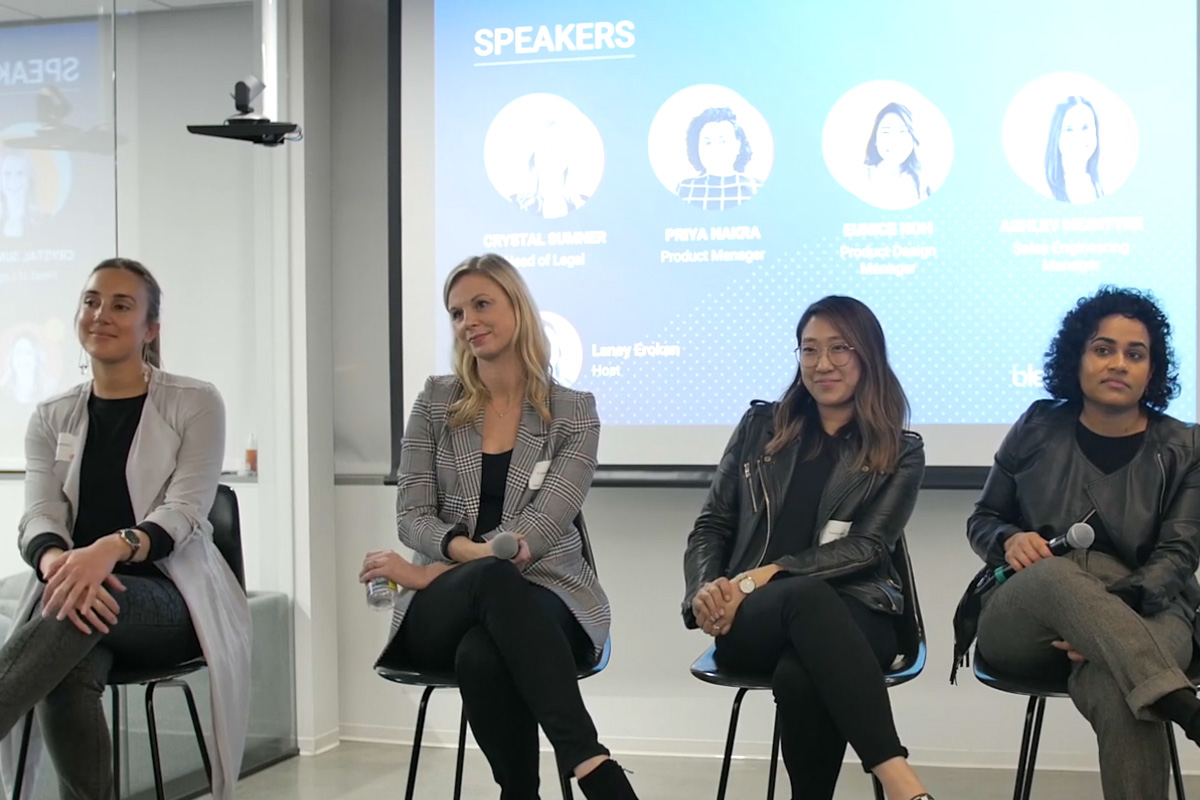
Blend girl geeks: Ashley McIntyre, Crystal Sumner, Eunice Noh, and Priya Nakra answering audience questions at Blend Girl Geek Dinner.
Our mission-aligned Girl Geek X partners are hiring!
- See open jobs at Blend and check out open jobs at our trusted partner companies.
- Does your company want to sponsor a Girl Geek Dinner in 2021? Talk to us!


